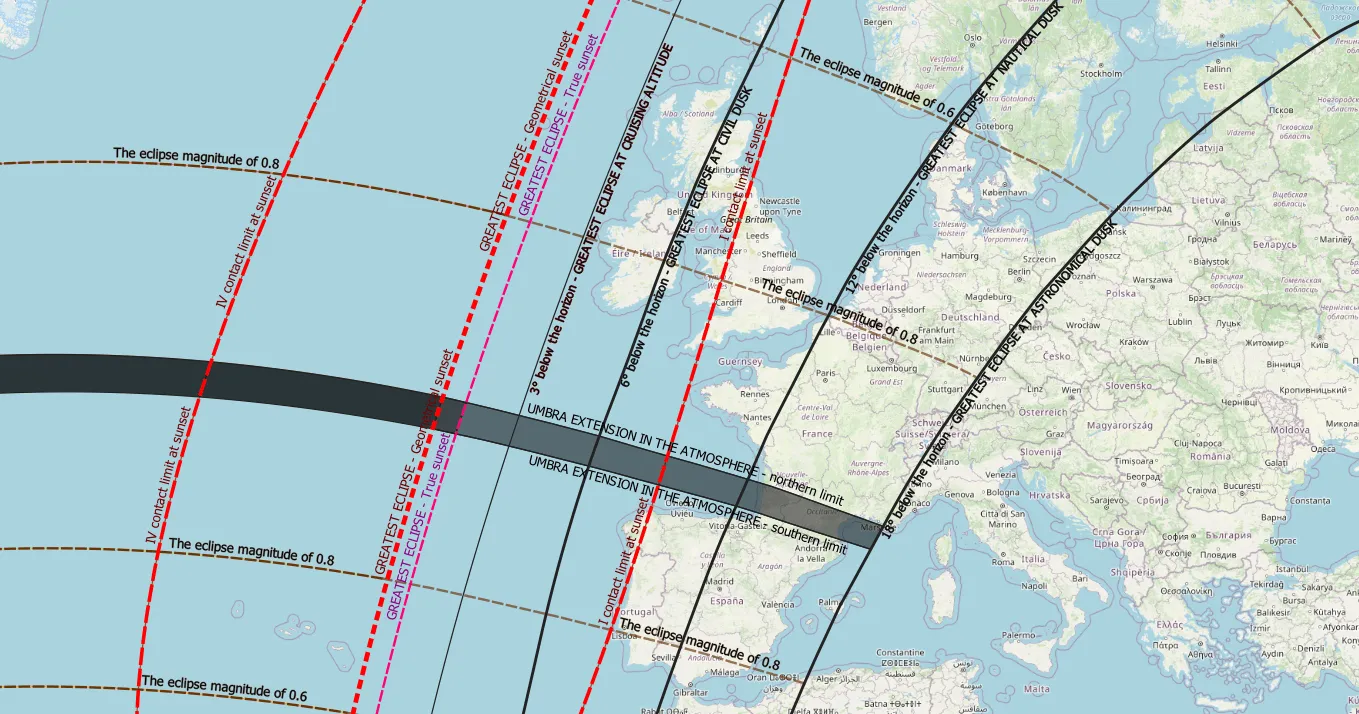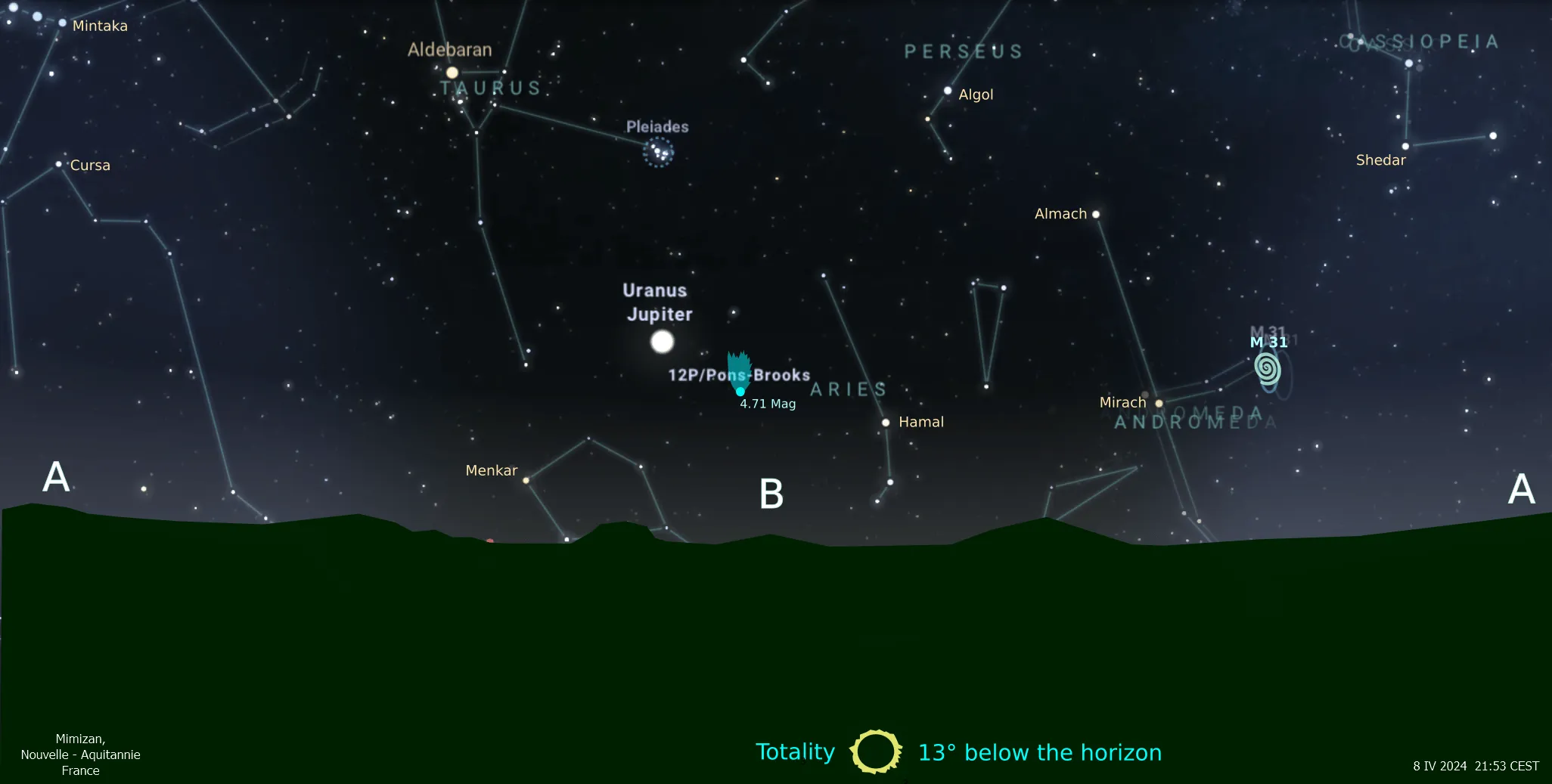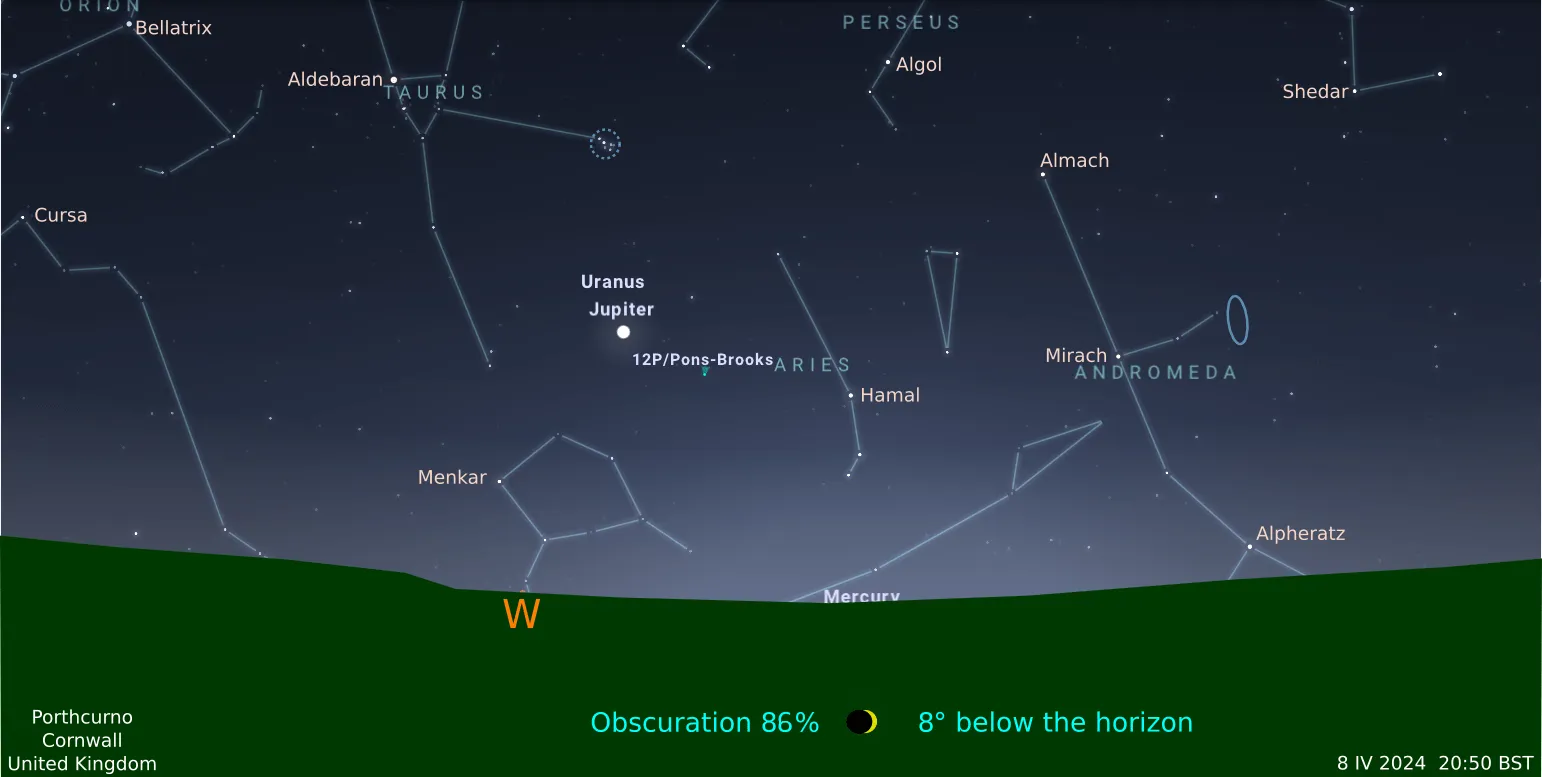12P/Pons Brooks comet during 2024 total solar eclipse
This text shows some guidelines for the brief moment of the total solar eclipse 2024 occurrence at twilight, which presumably will allow for a fantastic view of the 12P/Pons-Brooks comet being close to its perihelion point.
1. 12P/PONS – BROOKS COMET – GENERAL INFORMATION
12P/Pons-Brooks is a periodic, Halley-type comet, in which an orbital period counts 71 years. The name of the comet comes from its discoverer in 1812 – Jean Louis Pons and it was later recovered in 1883 – by William Robert Brooks. Its nucleus is estimated to be around 30km in diameter.
The presence of this comet was known earlier in historical times, especially during its favorable apparition in 1385, when it was observed from China, next in 1457 in Italy. The most favorable conditions, under which this comet could be observed are known from 673 when the comet could reach the brightness of +2 Mag.
In the year, when it was discovered, the comet could be spotted by the naked eye with a tail length of up to 2 degrees. 71 years later, on January 1884, the same comet reached the brightness of about 3 Mag.
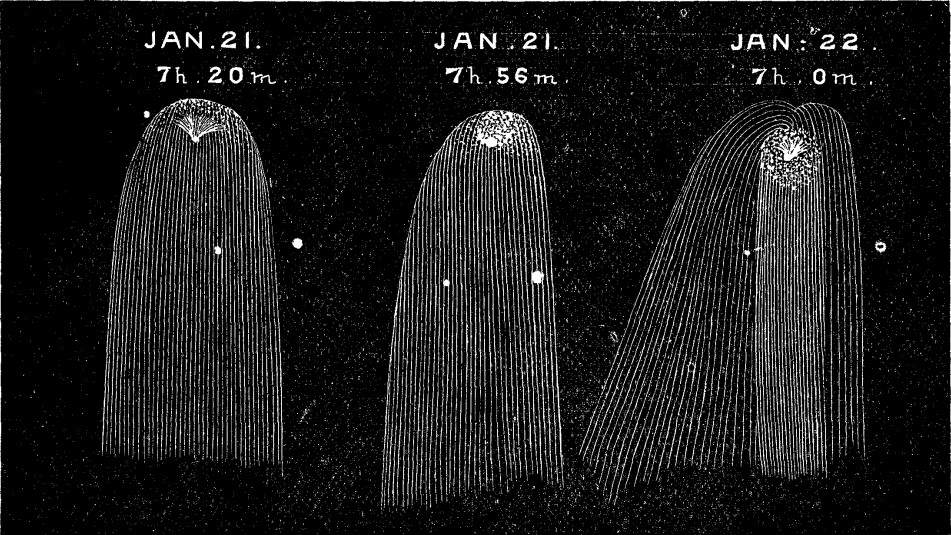
Pic. 1 The visibility of 12P/Pons-Brooks comet in January 1884 (H.C. Wilson/Wikimedia.org).
Another time, the 12P/Pons-Brooks comet was observed in 1954.
The orbit of the 12P/Pons-Brooks comet is inclined steeply to the ecliptic (74.2º) and can be sometimes perturbed by Saturn, However, its orbit remains stable between 1740 and 2167. The aphelion of the comet is beyond the orbit of Neptune (33.18 AU), and the perihelion is 0.78 AU. The comet can pass Earth as close as about 0.19 AU. Due to its orbit proximity, the comet has been classified by NASA as a “Near Earth Asteroid”. On the other hand, the object isn’t hazardous for our planet, which the computations say. The 12P/Pons-Brooks is possibly the parent body for the Kappa Draconids meteor shower, which occurs in December.
2. MAXIMUM APPARENT MAGNITUDE OF 12P/PONS-BROOKS COMET
The historical records prove the maximum apparent magnitude of the 12P/Pons-Brooks comet reaching around +4 Mag in August 1812, +3,5Mag in September 386, or even around +3 Mag in January 1884. What is most curious, some astronomers could see the abrupt brightening of the nucleus (0.7 Mag by just less than 2 hours!). There are historical reports of an even brighter appearance of this comet (between +3 and +2 Mag) from the XIV and XV centuries or AD673. In less favorable conditions, the brightness of the 12P/Pons-Brooks comet is estimated between +5 and +4 Mag. The very first record of the 12P/Pons-Brooks comet observations comes from AD 245 (Meyer, et al., 2020), whereas the orbit of comet 12P passed near the Earth’s orbit during the last 18000 years (Tomko, 2015). According to some theories, the fragment of the 12P/Pons-Brooks comet had broken off and impacted the Earth resulting in an explosion, in which much debris was thrown high into the atmosphere impending the sun rays for many years and decreasing the global temperature as a consequence. This information in fact isn’t confirmed by the scientific environment. The more reasonable theory is, that at least several hundred years ago 12P/Pons-Brooks comet had calved off its big part, which is now the 122P/de Vico comet.
Tab 1 12P/Pons-Brooks in historical apparitions
During the last approach in 1954, the viewing geometry wasn’t favorable and the comet wasn’t brighter than just +6 Mag. In 2024 the peak of brightness is estimated to reach about +5 Mag, so the comet will be at the edge of visibility of the human eye (Pic. 2).
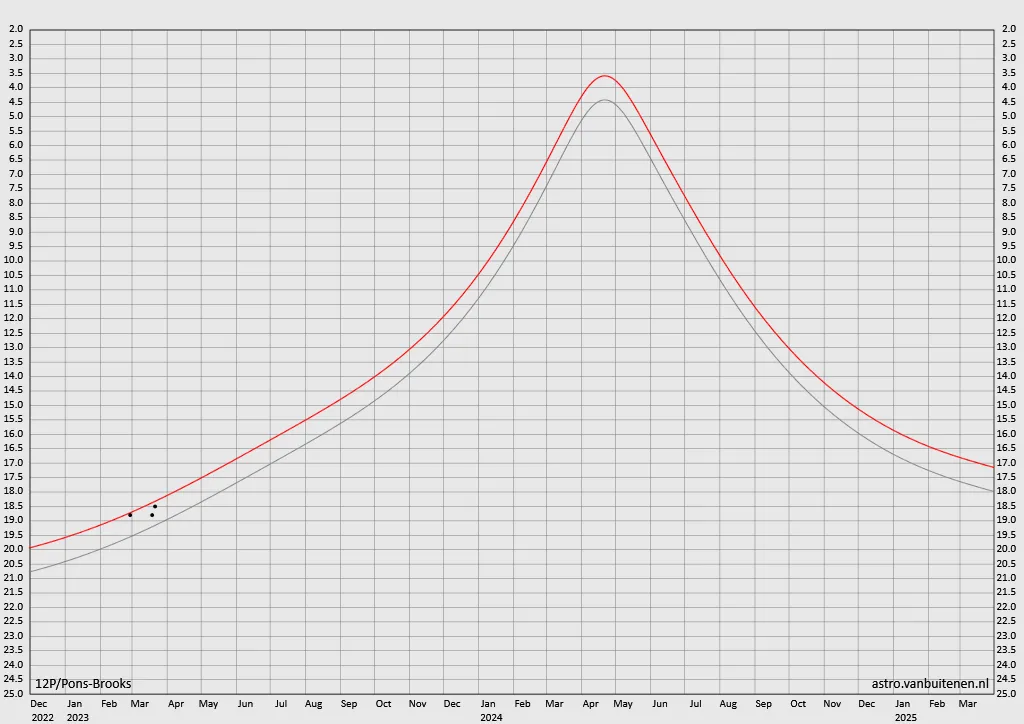
Pic. 2 The estimated brightness of the 12P/Pons-Brooks comet in 2024, where: the grey line – is based on the absolute magnitude and; the red line – is based on calculations made every 6 hours (Astro.vanbuitenen.nl).
3. 12P/PONS-BROOKS VISIBILITY IN 2024
The 12P/Pons-Brooks comet has been recovered again in 2020, just about 12 AU from the Sun (near the orbit of Saturn) which results from the new calculation about its estimated position near the forthcoming perihelion in 2024.
Unfortunately, the viewing geometry of the 12P/Pons-Brooks comet won’t be favorable, as during the run-up to perihelion the comet will be located on the far side of the Sun from Earth. The only fact, which explains away some good visibility conditions is the location of this comet well to the north of the Sun. The perihelion passage in late April 2024 will occur at the separation of 22º from the Sun. In general, the conditions will be slightly better than recently in 1954.
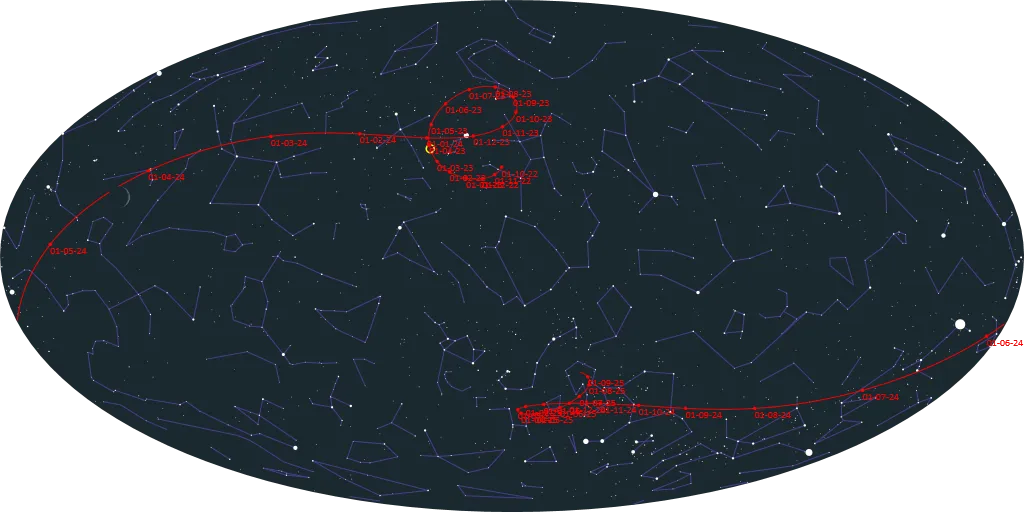
Pic. 3 The 12P/Pons-Brooks comet position through its entire period of approaching the perihelion (2022-2025). The yellow point indicates the comet position at the time of production of this text (Astro.vanbuitenen.nl).
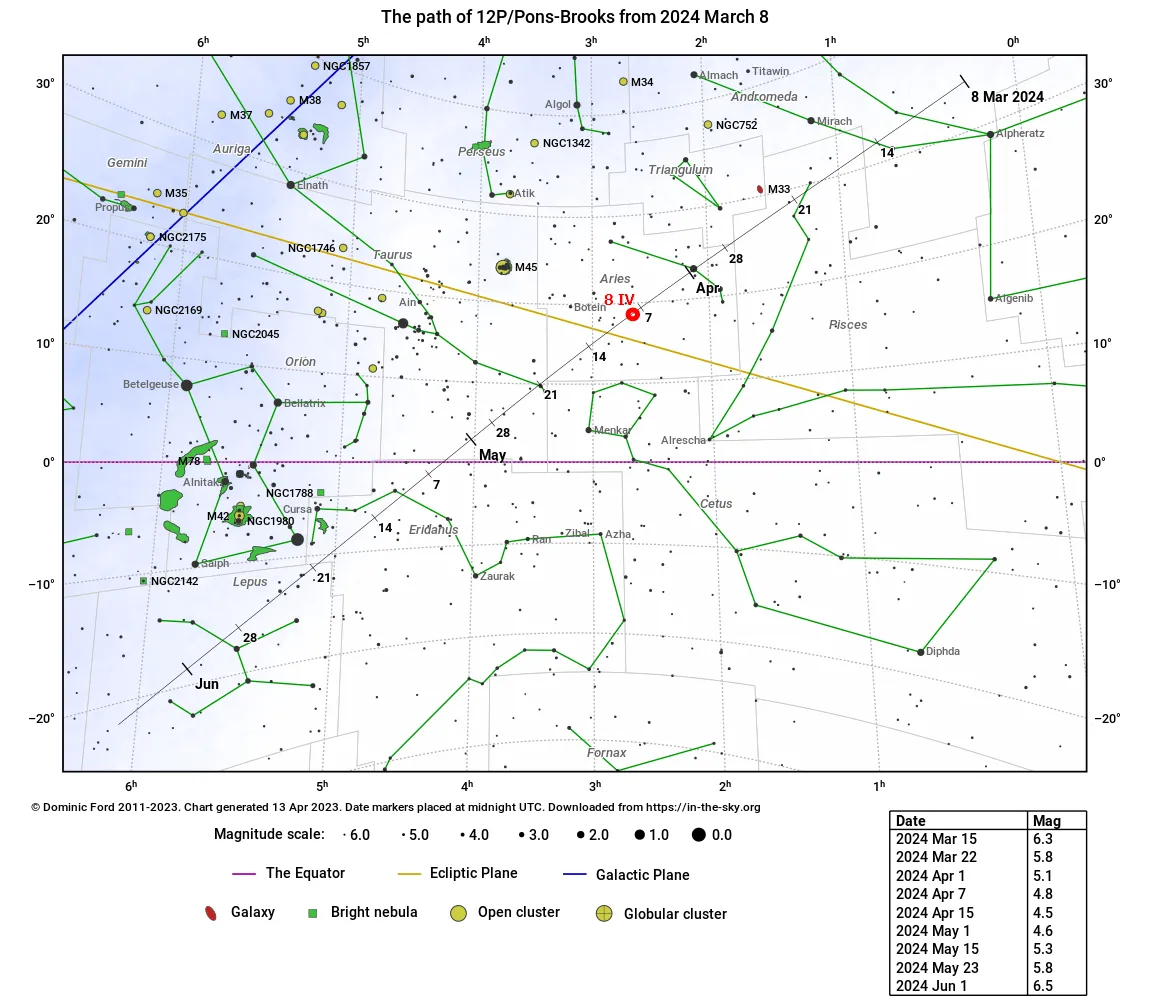
Pic. 4 The way of 12P/Pons-Brooks comet across the sky between March 8 and June 8 2024 with the April 8 marked on the way (in-the-sky.org). Click to enlarge.
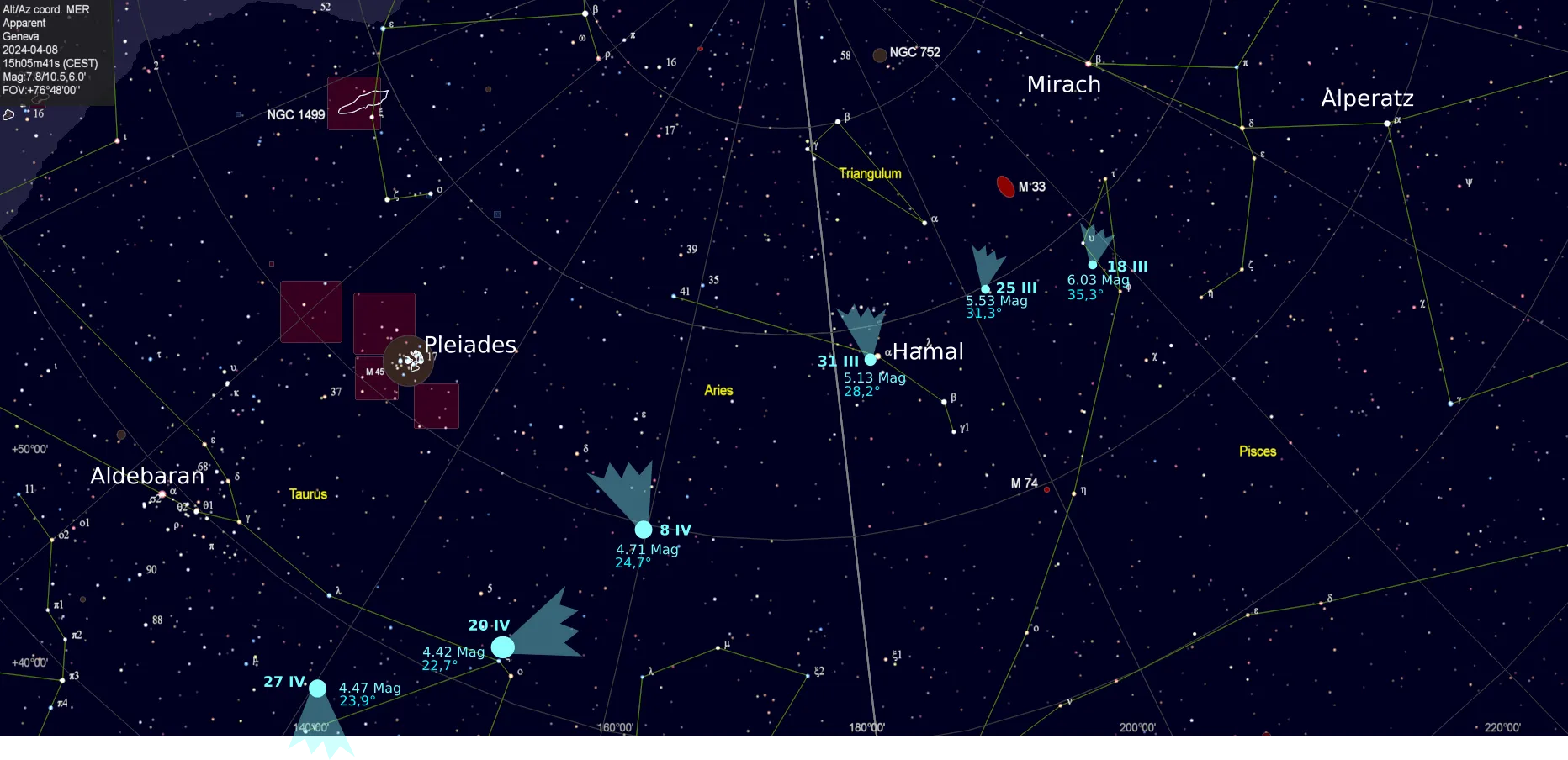
Pic. 5 The detailed sky map with some 12P/Pons-Brooks positions between March 8 and April 27, within which the visibility for European observers appears to be the most favorable. Click to enlarge.
Due to the position of the Moon, the best moments of 12P/Pons-Brooks visibility will occur in early April and late April-May 2024. The perihelion on April 21 will coincide with the full Moon. Indeed, the small elongation will mean, that the comet will occupy predominantly the twilight sky.
4. 12P/PONS-BROOKS AND 2024 TOTAL SOLAR ECLIPSE IN NORTH AMERICA
Assuming, that as per calculations the brightness of the 12P/Pons-Brooks comet will reach about +5 Mag in early April, the object would be barely seen by the unaided eye in the night conditions beyond the twilight zone. Shall anyone expect to spot this comet during the 2024 total solar eclipse? Theoretically isn’t possible, as the full totality will bring the twilight conditions known from the solar depression about 6º. The important thing, used to describe the 12P/Pons-Brooks comet at its peak of brightness was some “occasional outburst” which could lift up its brightness for a while. In fact, observers could be extremely lucky to have an outburst such as this exactly during totality. From the theoretical point of view, since we are considering unfavorable conditions for the perihelion occurring about 2 weeks later near the full Moon, we shouldn’t expect this comet to be easily visible under total solar eclipse conditions. Apart from the omnipresent light scattered in the atmosphere, we can’t forget that the solar corona also shines with a brightness comparable to the full Moon! Concluding it is a very low chance of seeing the 12P/Pons-Brooks comet during the 2024 total solar eclipse, but out of interest we can get to know about the location of this object during the event (Pic. 6).

Pic. 6 The celestial location of the 12P/Pons-Brooks comet during the 2024 totality (SkySafariAstronomy.com/Facebook.com/GreatAmericanEclipse).
The biggest attitude of the 12P/Pons-Brooks location will be the angular distance to the eclipsed Sun. The small elongation, just 24º on April 8 will mean, that the comet will fall in the same field of view as the totality! In fact, the predicted magnitude of 4.7 is equal to the Zeta Cancri star. If you know this star, try to find it under at least early nautical twilight conditions (Pic. 7). Looking at it from another positive side is the location of the comet very close to Jupiter, which will be a good indicator for sure. If the comet could be better visible (at potential outburst) it could be a fantastic target for photographers. To be honest, even a good binocular doesn’t guarantee the visibility of this comet along with the eclipsed Sun, but the event itself is worth following anyway.
As per nice scientific investigations it was found, that the celestial objects with an apparent magnitude similar to the estimated for the 12P/Pons-Brooks comet on April 8, 2024, would be visible only at the solar depression of about 9-10°, assuming that an observer has a “standard” eyesight (Nickiforov, 2011). If the apparent brightness of the comet reaches +4.2 Mag, then would be visible at a solar depression of about 8° (Pic. 7). These assumptions apply to the clear atmosphere conditions when the celestial body is higher than 40º above the horizon (Nickiforov, 2011).
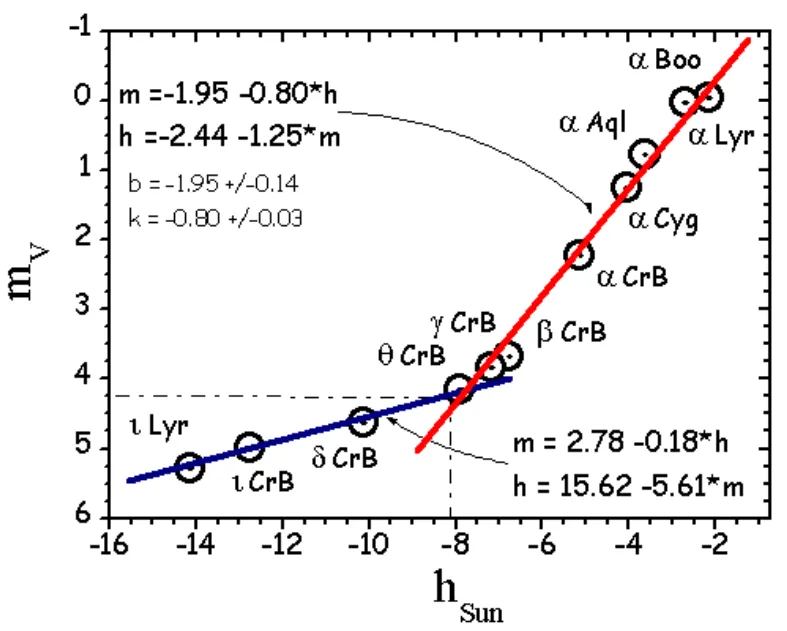
Pic. 7 Standard visibility of stars at twilight – the dependence of the extremely visible stellar magnitude (mv) on the particular depression of solar disk (hs)(Nickiforov, 2011).
In conclusion, since the total solar eclipse of 2024 is considered just within the North American continent, this view seems impossible, unlike the near-horizon totality occurrence in the North Atlantic region, where the brightness of the sky can resemble the 8º of solar depression.
5. 12P/PONS-BROOKS AND 2024 TOTAL SOLAR ECLIPSE TWILIGHT IN EUROPE
Since it was observed, that the totality, which occurs near sunrise or sunset can bring 8º nautical twilight conditions, an observer shall expect better visibility conditions for this comet, when the eclipsed Sun goes down below the horizon in a geometrical sense. The twilight belt, which counts about 1100 sea miles in width, from the sunrise or sunset meridian to full night (Tousey, Koomen, 1953) is the area, from where the total solar eclipse isn’t visible and everyone will agree that it. In fact, the absence of the eclipsed Sun doesn’t mean, that nothing happens in the atmosphere this time, which was proved by some authors as well as in my own observations made earlier. Taking into account the dependency between the particular solar depression and the progress of twilight adequate to it we should consider the serious disturbances, which are explained later in this text. Simplifying, the twilight at the given position looks usually considerably darker, than normal. It applies also to the regions hit by a penumbra, about which you can read later.
On April 8 evening, the 12P/Pons-Brooks comet will be visible in western Europe at a maximum altitude of 6° above the horizon at the moment of astronomical twilight. The best conditions (except for the eclipse impact) will apply to the southernmost parts of the continent. The elongation of the comet to the Sun on April 8 evening will be about 25º, although the difference in declination between 2 bodies will be still big. The declination of the Sun on April 8 will be at 7°18’26,4″ whereas the declination of 12P/Pons-Brooks will decrease to +18°45’41”. A difference such as this indeed will theoretically extend the observable time of the object, especially at high northern latitudes, but each observer must be aware of the low altitude of the comet’s visibility. It means, that atmospheric extinction will be dominant. Combining this factor with a still bright twilight sky makes the observation of the 12P/Pons-Brooks comet rather unrealistic. In lower latitudes, where the comet set occurs after astronomical twilight, the observation conditions will be better. In fact, the 12P/Pons-Brooks comet near its perihelion is a near-sun object. It means, that the visibility slot when the object is above the horizon with no Sun visible is short. Considering the changing altitude of the object against the twilight progress, an observer shall expect the moment of the best visibility of this near-sun object. This particular moment called the “maximum” features the biggest difference in brightness between the object and its background (twilight sky) The length of this “maximum” depends on the proximity of the celestial object to the horizon (Pic. 8).
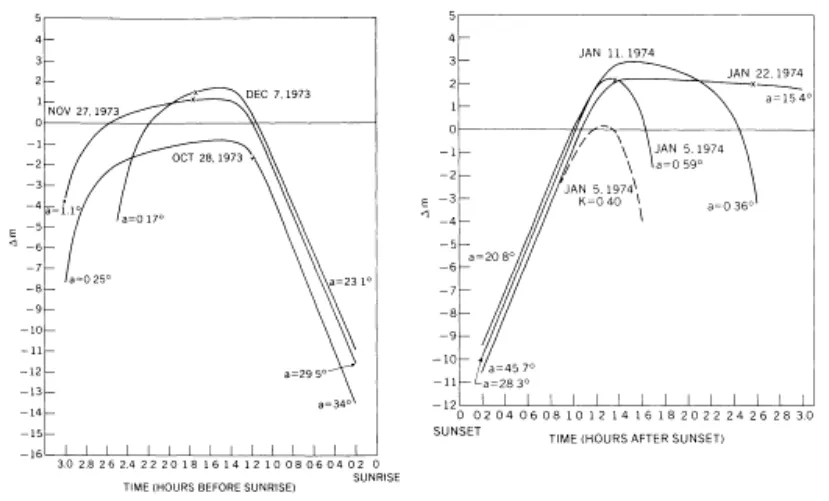
Pic. 8 Kohoutek comet visibility (+3 Mag) at twilight in late 1973-1974 with its “maximums” of best visibility occurring in general about 1.5 hours before sunrise and after sunset, where Δm means the relation of object brightness to the brightness of the background sky (Kastner, 1976).
The example above depicts the relation of the brightness of the Kohoutek comet (+3 Mag) to the brightness of the background sky. The crucial value here is the Δm, which is a result of the final visibility function (Δm = 2.5Log R). It shows negative and positive values on the chart. Only the positive values mean, that object has an excess brightness exceeding that of the sky background (Kastner, 1976). In other words, only when Δm is above 0, an observer can try to see the object in the twilight-illuminated sky. As the Δm value goes higher, the visibility conditions are undeniably better until reach their “maximum” moment explained above. Admittedly, an analog chart could be applied to the visibility of the 12P/Pons-Brooks comet, but bear in mind, that the apparent magnitude of this object is just +4.42 Mag (on April 8 evening +4.71 Mag). The charts clearly show the dependency between an object’s altitude and background sky illumination.
As the object is observed lower above the horizon, its brightness is more deteriorated by atmospheric extinction and its sharpness by atmospheric turbulence regardless of decreasing brightness of the twilight sky or even faint night sky luminance. The atmospheric extinction coefficient is surely different for the well-located astronomical observatory and urban areas. This factor is also driven by the degree of atmosphere clarity. The position of the 12P/Pons-Brooks comet on the April 8 evening will partially resemble the position of the Kohutek comet on January 5 1974 evening in the company of the two brightest planets – Venus and Jupiter (Pic. 9).

Pic. 9 The visibility of Kohutek comet along with Jupiter and Venus, which the object was in conjunction with on January 5 evening 1974, where a means altitude above the horizon (Kastner, 1976).
On April 8 evening, the 12P/Pons-Brooks will approach Jupiter and Uranus. The graph above shows the difference in visibility conditions, which will be very similar in the next year at nearly the same time. Since Jupiter remains visible until it goes below the horizon, the faint comet such as 12P/Pons-Brooks will drop below the visibility threshold much earlier before it sets behind the horizon.
Concluding, we should deal with 4 major factors, which shape near-sun object visibility at a given moment (Kastner, 1976):
– the optical extinction of the atmosphere as a function of the object’s altitude,
– the brightness of the object as viewed beyond the Earth’s atmosphere,
– the solar depth, which determines the background sky brightness during twilight,
– night sky luminance, visible mostly after astronomical twilight, which includes starlight, airglow, and zodiacal light.
It could be also worth adding the difference between the azimuths of the Sun and the object. The dependence between solar depth and azimuthal angle is important given the fact, that when moving outward from the solar azimuth, the twilight sky becomes less illuminated.
Assuming, that the best moment for visibility of the 12P/Pons-Brooks comet would occur at the moment when astronomical twilight ends, its altitude above the horizon will vary between 3° and 6° across the continent (central Scandinavia – southern Spain). Despite the increasing brightness of the comet (peak on April 25) its position will change and become more unfavorable for European observers. On April 25, the declination of 12P/Pons-Brooks will be just +07°06’36”, whereas the declination of the Sun will reach +13°16’54,6″, moreover the full Moon will occur. The comet won’t be achievable at the end of astronomical twilight in Europe. The latitude of about 30°North will mark the presence of the comet above the horizon at the moment when the twilight ends completely. Therefore the twilight extension of the total solar eclipse in North America and the North Atlantic shall mark an unprecedented “window of time”, in which all observers in south-western Europe should concentrate their efforts on chasing this remarkable Halley-type object.
6. PERSPECTIVES FOR WATCHING THE 2024 TOTAL SOLAR ECLIPSE IN WESTERN EUROPE
Apart from North America, there are some bits of lands belonging to Europe, where the same eclipse is to be seen. Unfortunately, only the partial phase will be seen from there, as the path of totality ends up at the terminator line around 1400 km from Nouvelle-Aquitannie landfall. Despite the explanations of how this phenomenon occurs, which have been made earlier i.e. in this text, I can bring again the graphical depiction of the European eclipse event on April 8, 2024.

Pic. 10 The general visualization of the tail end of the 2024 total solar eclipse from the Moon’s observer perspective (Michael Zeiler/FB/Solar Eclipse Chasers).
The moment, when the totality reaches completion is to occur at 19:54 UTC about 900km from Spanish (Galician) and 1400km from French (Nouvelle-Aquitannie) shores. The duration will be 2m13s, which is quite impressive for horizontal total solar eclipses. Next, the shadow will go higher up in the atmosphere and leave the Earth’s surroundings completely, leaving just penumbra behind. Looking at it from the mapping perspective, we can see a nice coincidence of lunar shadow with the twilight (Pic. 11).
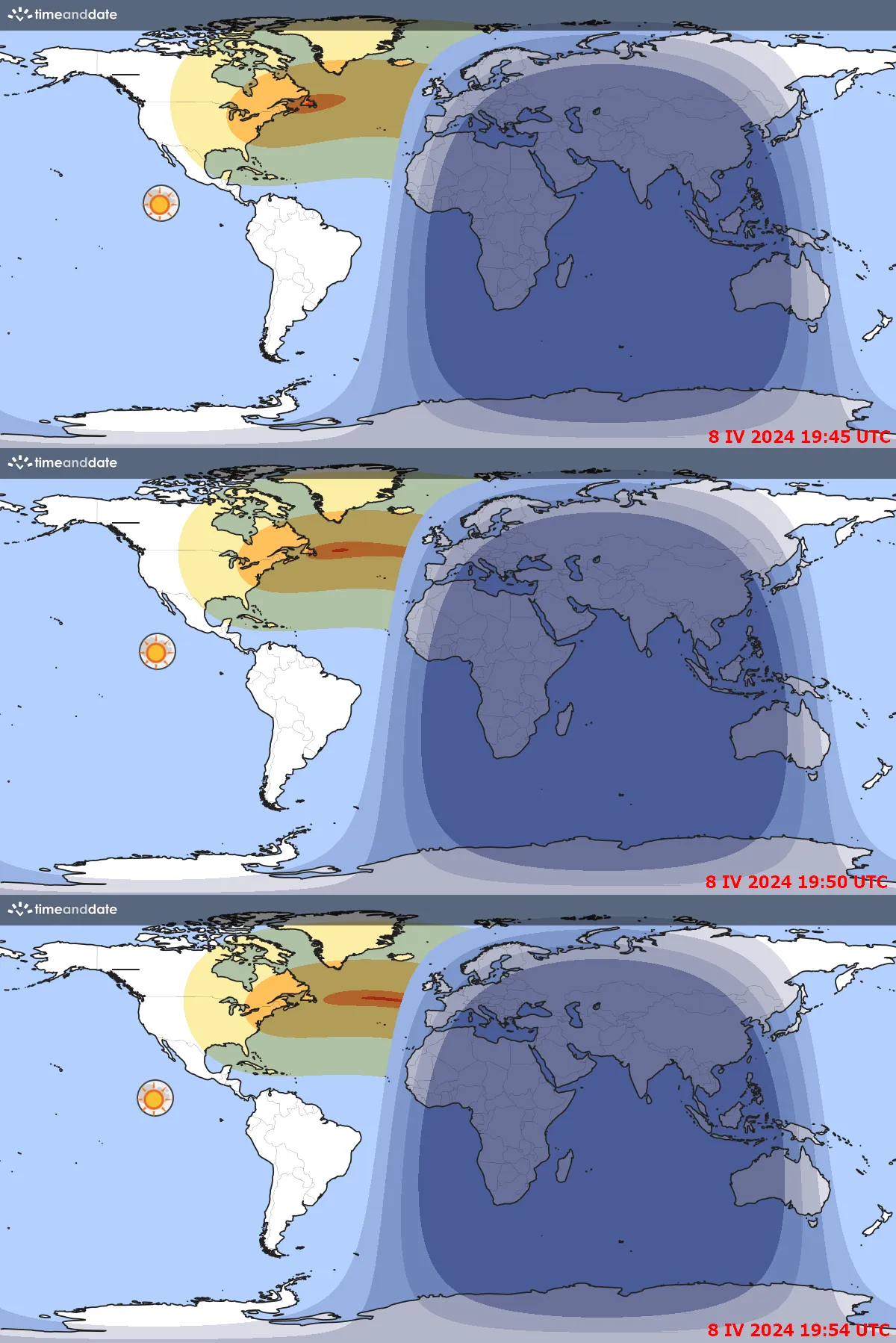
Pic. 11 The tail end of the 2024 total solar eclipse is presented on the day & night map (Timeanddate.com).
The moment, when the 2024 totality ends up at North Atlantic resembles the single-limit total solar eclipse for a while. This type of eclipse occurs when only part of the shadow passes over the Earth (Meeus, 2007). Conversely to the single-limit total solar eclipses, in which the umbra moves perpendicularly to the most extremal part of the Earth, in the case of two-limit totality, the umbral movement is perpendicular or at least diagonal against the Earth’s surface at the terminator line. It’s an undeniable fact, that the combination of the lunar shadow with the Earth’s shadow creates somewhat the “double shadow” phenomenon (Pic. 11), as described in Guyliev’s work (Guyliev, 1992).

Pic. 12 The “Double-shadow” phenomenon is expected to occur in Western Europe at the end of the 2024 total solar eclipse.
This double-shadow from an observer’s point of view, who stands within the twilight belt creates the extended dark path from the solar to the antisolar direction. When considering the period of dusk in Western Europe, then the aforementioned dark belt should proceed from the northern to the southern limit before it vanishes in the atmosphere. Apart from the extension of the main path, lots of people will definitely notice the serious twilight disturbance driven by the deep penumbra. The phenomenon, which will happen right after the greatest phase of the partially eclipsed sun below the horizon can be called twilight standstill. This is the moment when the twilight process stops in the optical sense. The decreasing magnitude of the eclipse allows for more light to come from our mother star, which goes deeper below the horizon at once. As a consequence, no difference in illumination of the local scene is observed or at least it’s too minor to be noticed by an observer’s eye. The twilight standstill on April 8 evening in Western Europe will be proceeded by accelerated dusk caused by a doubled reduction of the scattered sunlight both by increasing solar depression and the magnitude of the eclipse.
The map above shows the extension of the 2024 solar eclipse in Western Europe. The path of totality ends west of Spain and France, but the visibility of the umbra in the twilight sky is estimated to be visible down to the end of astronomical twilight south of Marseille. Practically nowhere on the European mainland, the eclipse will start before sunset, therefore the event is treated as not observed in many sources. Indeed it can be noticeable as a twilight disturbance later with the greatest phase between.
For deeper insight, I’ve considered the circumstances for three major locations in Western Europe in order to visualize how this event would look like in the company of the 12P/Pons-Brooks comet, not to mention, that within the umbral extension inside the twilight zone, the conditions for watching this comet appear to be the best over its whole near-perihelion period!
I took into account three places with significant eclipse phases at dusk. Their common denominator, unfortunately, is not a promising weather prospect, as all of them are under a strong influence of the Gulf Stream, which shapes the climate all year around. The spring is the moment of rebuilding the baric situation. The semi-permanent Icelandic low most active in the winter period yields another semi-permanent, the Azores High, active in the summer. For all the locations bound within the southern UK and northern Spain, the weather in early April is pretty much similar and features mild temperatures combined with quite frequent cloudiness and precipitation, which comes straight from the Ocean. As is worst all the observation venues lie at the shore because of its biggest proximity to the geometrical end of the eclipse path. In practice, observers could expect an additional adiabatic lift of the moist air, which can result from the horizontal layering of low-level clouds. In all the considered locations the polar air mass takes hold, which features higher moisture.
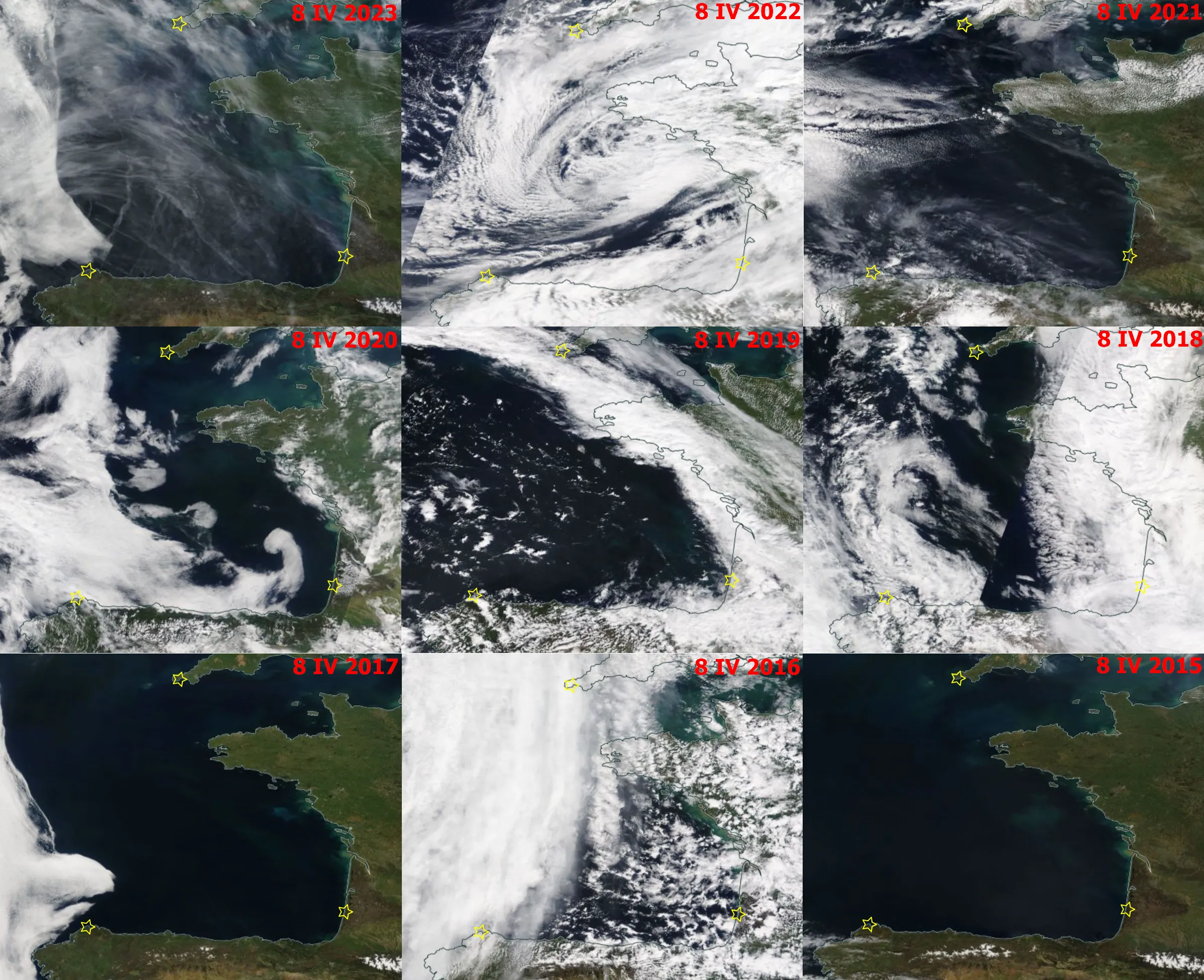
Pic. 14 The cloud coverage above Western Europe (between southern UK and northern Spain) in the last 9 years (2015-2023)(Worldview.earthdata.nasa.gov). Click to enlarge.
The satellite data above show the real situation over the last 9 years (including this year). The probability of bad weather is literally 50/50, although a tad better prospect seems to be for the French Britanny region, where the greatest phase is estimated to occur about 9° below the horizon (mid-nautical dusk) with an impressive obscuration of 93%. This region hasn’t been considered, as the event circumstances will be probably quite similar to northern Spain. In fact, chasing the extended umbra will be less possible due to the distance of 250km (about 2x more than from Spain and southern azimuth (quite far from the solar one), but the degree of illumination of the scene should be comparable. The yellow stars in the image above (Pic. 14) mark the places considered and described in details below.
MIMIZAN (NOUVELLE-AQUITANNIE, FRANCE)
This is a small coastal village located south of Bordeaux, where the greatest eclipse is expected to occur at 21:53 local time (UTC+2) at the beginning of astronomical dusk (solar depression of about 13°), which means, that the partial phase will start nearly at the end of civil twilight. The weather on April 8 gives just a 25% chance for a totally clear sky (Pic. 15), whereas, for over 50% of cases, it was totally overcast.
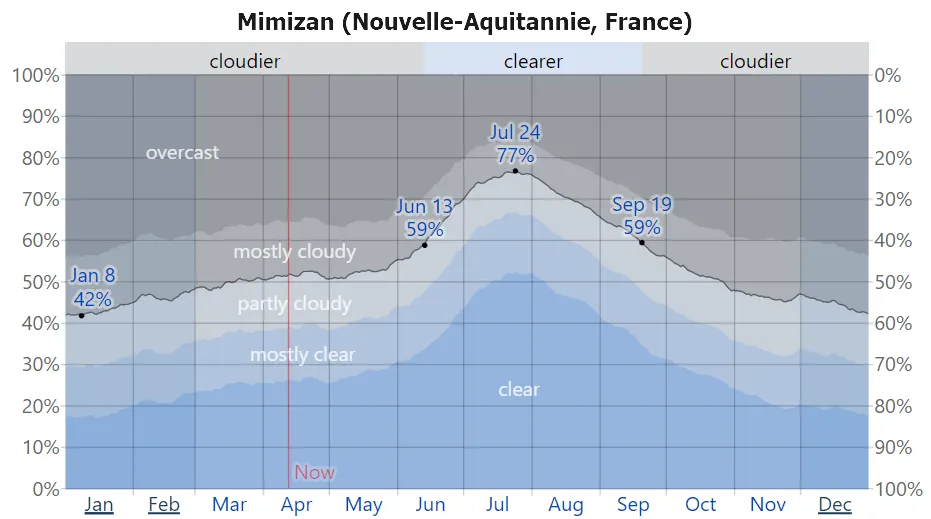
Pic. 15 The annual cloud coverage in Mimizan (Nouvelle-Aquitannie, France) with the day of April 8 marked as the red line (Weatherspark.com).
This is the place with the deepest twilight considered because, at the moment of the greatest eclipse, the Sun will be almost 13° below the horizon (Pic. 16).

Pic. 16 The location of the Mimizan coastal village against the extended path of totality within the astronomical twilight zone. Click to enlarge.
We can guess, that the conditions will resemble the full night as occurs beyond the end of astronomical dusk (Pic. 17).
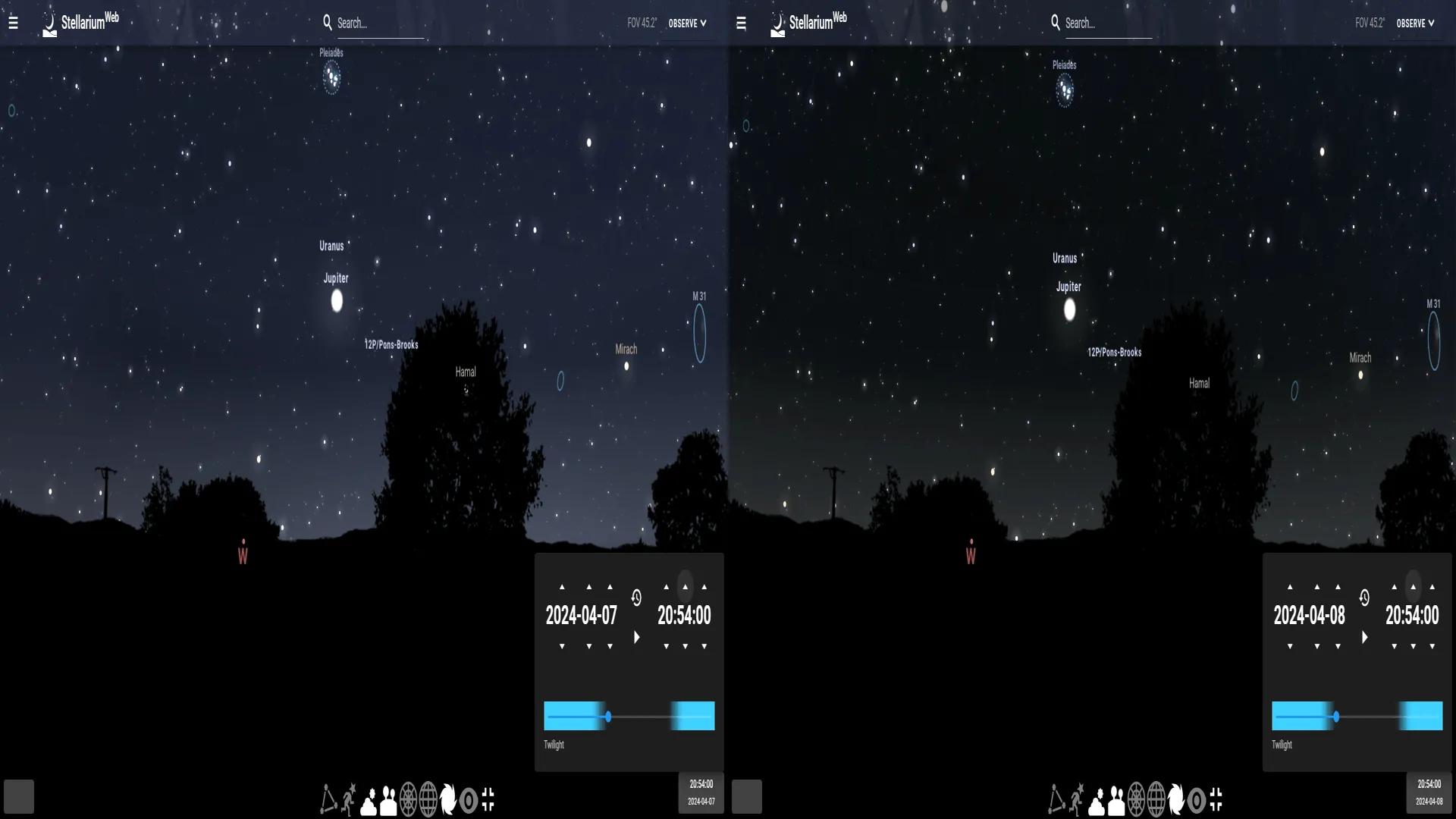
Pic. 17 The comparison of twilight between the 2024 eclipse twilight and a day before with the visibility prospect for 12P/Pons-Brooks comet in Mimizan (Stellarium-web.org). Click to enlarge.
However, the observers shall expect some brightening of the horizon on the left and the right from the aforementioned umbral zone. The visibility of the 12P/Pons-Brooks comet should be the best, much better than elsewhere considered (Pic. 18, 19).

Pic. 18 – 19 The situation in the sky at the greatest eclipse occurrence. The total solar eclipse will geometrically occur around 13° below the horizon, where: A – twilight sky illuminated by partially eclipsed Sun, B – double-shadowed sky. For a casual observer only the swath of the shadow should be visible with the 12P/Pons-Brooks comet somewhere in the middle (Stellarium-web.org – modified).
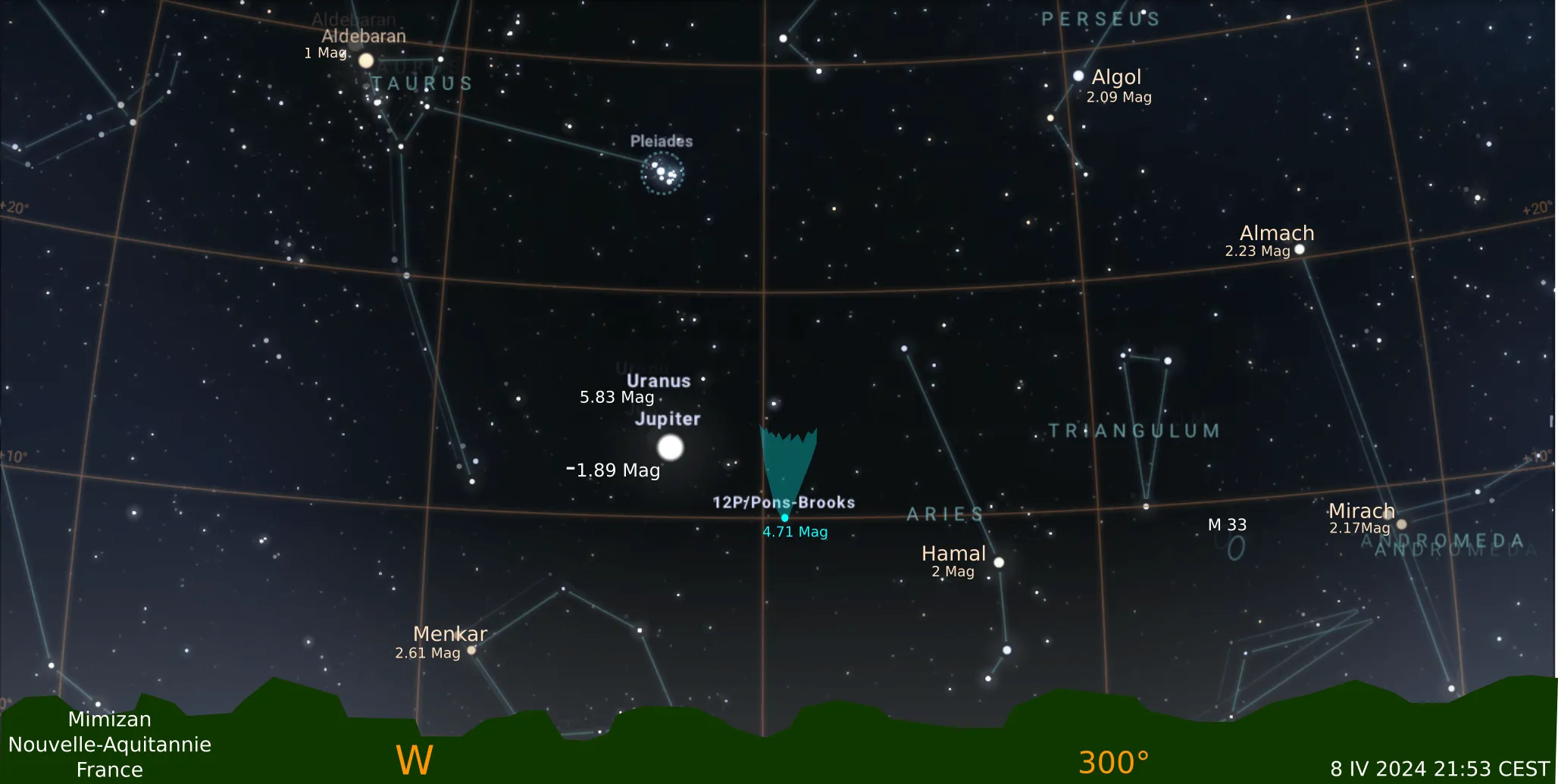
Pic. 20 The detailed view at the 12P/Pons-Brooks position in the sky during the total solar eclipse below the horizon is estimated to be observed from Nouvelle-Aquitannie shores (Stellarium-web.org – modified).
It will be because the 12P/Pons-Brooks comet will shine with a magnitude of +4.71 about 10º above the horizon. At this altitude, atmospheric extinction isn’t troublesome that much in clear air masses. The object will be possible to find slightly right from Jupiter – the brightest object inside the extended umbra and left of Hamal – the brightest star in the Aries constellation. It will be the highest possible altitude of 12P/Pons-Brooks comet for non-twilight conditions on land! It applies to its whole near-perihelion period!
CARINO (GALICIA, SPAIN)
Carino is a small municipality in the northwestern corner of the Iberian Peninsula, which is expected to experience a deep partial phase of the eclipse below the horizon. Regrettably, the weather seems to be very similar to a previous location with just less than a 20% guarantee for completely clear skies and slightly less than 50% cases with clouded skies (Pic. 21).

Pic. 21 The annual cloud coverage in Carino (Galicia, Spain) with the day of April 8 marked as the red line (Weatherspark.com).
The whole surroundings are expected to experience the peak of the eclipse at a solar depth of 9°, which corresponds to mid-nautical dusk. Despite the coastal location of the municipality, there are places nearby with altitudes reaching hundreds of meters above sea level. It can be a crucial advantage in the case when the horizontally-layered stratus clouds will appear above the coastline. These places might be simply above the lowest cloud deck.
The greatest eclipse will exceed 96% obscuration, and the visibility of the umbral swath passing by in the atmosphere is fairly possible, as the distance to its southern limit will be less than 130 km (Pic. 22).

Pic. 22 The location of the Carino coastal village against the extended path of totality and deep penumbra within the astronomical twilight zone. Click to enlarge.
Unlike the French coast, northwest Spain will see the very beginning of the partial phase of the eclipse, which at sunset should reach an obscuration of about 4%. The civil dusk will be affected dramatically by the increasing phase of the eclipse and the mid-nautical dusk should resemble the conditions typical for early astronomical twilight (Pic. 23).
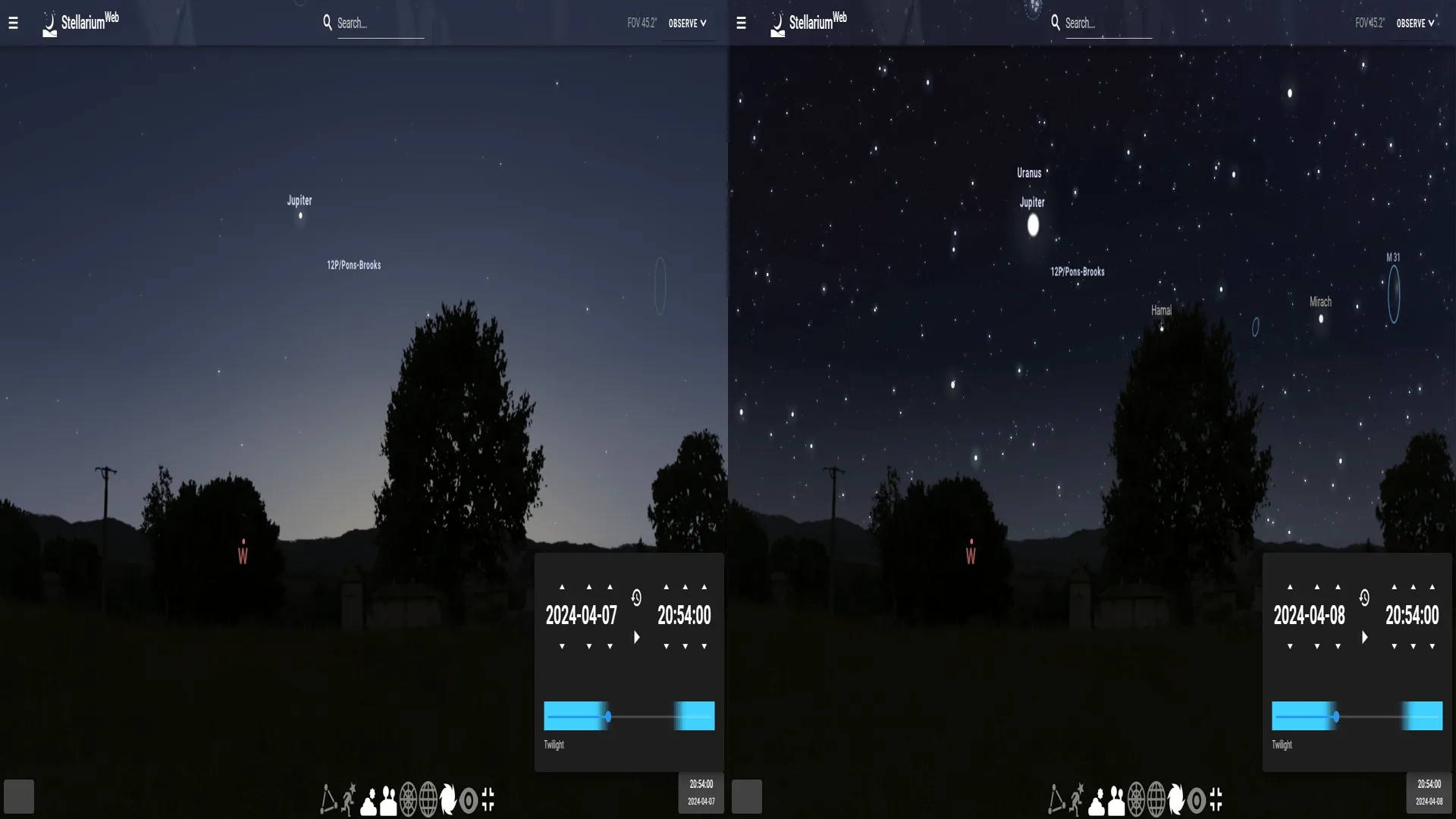
Pic. 23 The comparison of twilight between the 2024 eclipse twilight and a day before with the visibility prospect for 12P/Pons-Brooks comet in Carino (Stellarium-web.org).
The azimuth of the extended umbra will be very similar to the solar one, therefore the visibility of it at least for a brief moment, shouldn’t be a problem (Pic. 24). The greatest phase is estimated to occur at 21:54 local time (GMT+2).

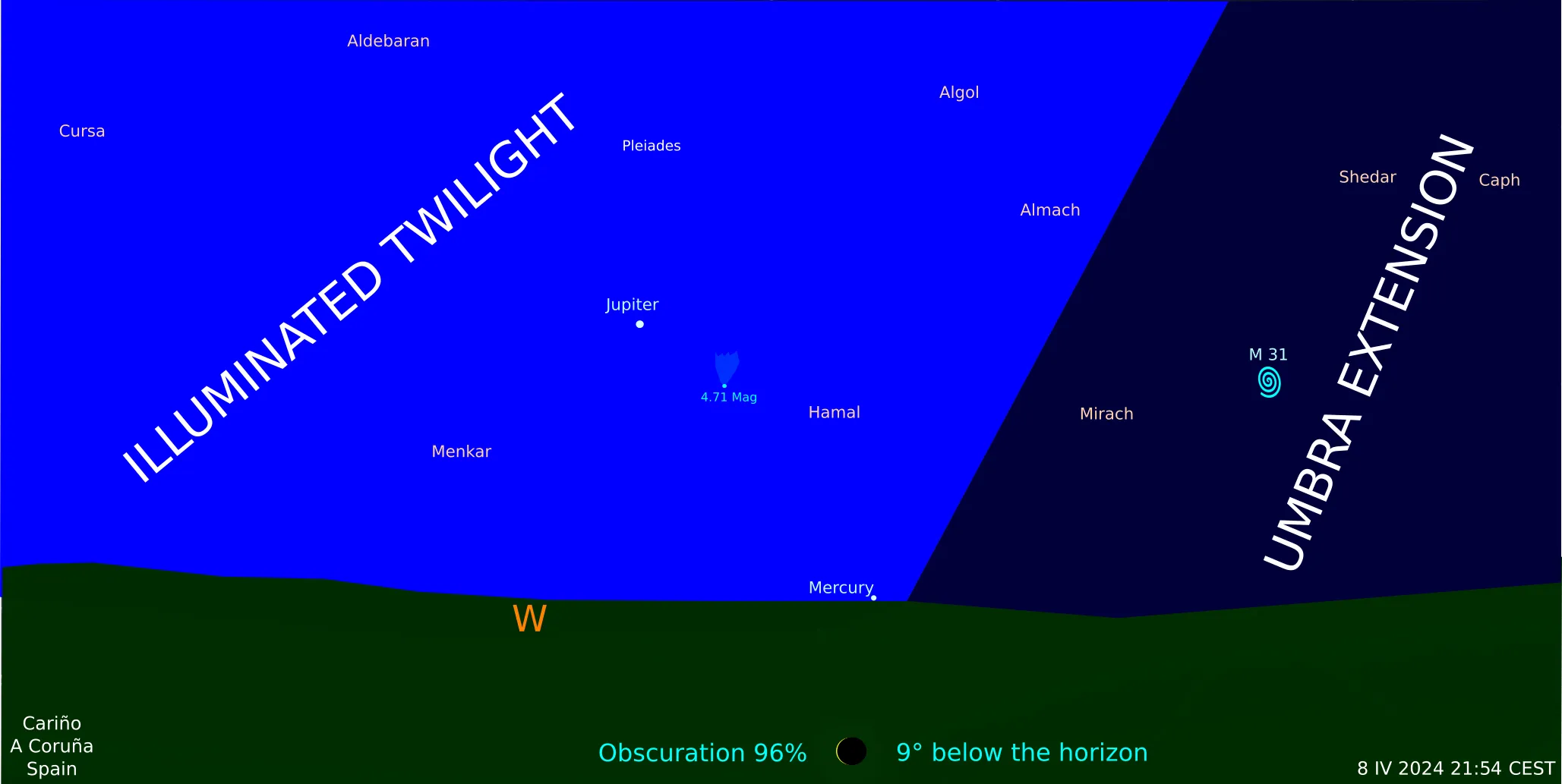
Pic. 24-25 The situation in the sky at the greatest eclipse occurrence. The deep partial solar eclipse will geometrically occur around 9° below the horizon, where: A – twilight sky illuminated by partially eclipsed Sun, B – double-shadowed sky. For a casual observer, the swath of double shadow should be noticeable on the right, but the 12P/Pons-Brooks comet will be faintly visible in the illuminated twilight sky (Stellarium-web.org – modified).
The conditions for the 12P/Pons-Brooks comet observation will be significantly worse from this location, as the object won’t fall inside the extended umbra visible by a casual observer on the right. Indeed, they will be still much better than for non-eclipse conditions and probably still the best for the entire near-perihelion period of this Halley-type comet.
Because of the earlier stage of the dusk, the comet will be placed much higher in the sky (Pic. 26).
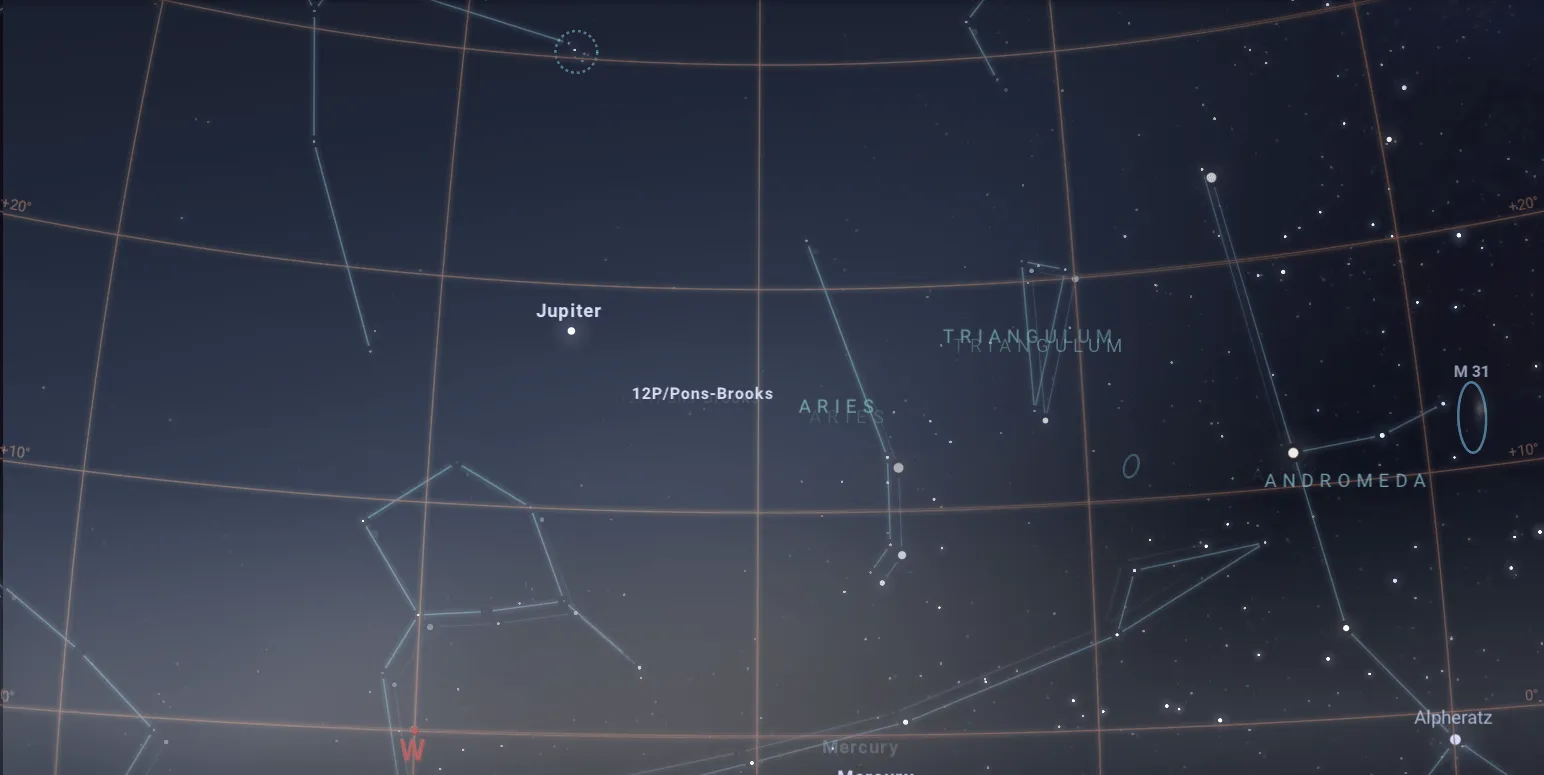
Pic. 26 The detailed view at the 12P/Pons-Brooks position in the sky during the total solar eclipse below the horizon is estimated to be observed from Galician shores (Stellarium-web.org – modified).
Its altitude will be as high as 14º above the western horizon. Both Jupiter and Hamal will be visible in conditions such as these, therefore finding the comet shouldn’t be a problem for unaided-eye observers. It’s highly likely, that the M31 can be also captured in one shot as it’s estimated to be located within the extended path of totality for a while. On the other hand, even the total obscuration of the Sun from this location wouldn’t accommodate the full night conditions, because the depth of our mother star is still too shallow. Personally, I think, that this location will provide the most interesting view of the 2024 solar eclipse below the horizon phenomenon from Europe.
PORTHCURNO, CORNWALL, UK
This picturesque village can be also an interesting spot for casual observers on April 8 next year. The magnitude of the eclipse is the lowest considered, but the dusk disturbance will still be significantly noticeable followed by the twilight standstill phenomenon very similar to the annular eclipse of June 10, 2021, watched from the northern USA. The weather likewise in other locations won’t be favorable at all and just a bit above 20% of cases display the pristine sky without any clouds contrary to over 50% of cloudy cases (Pic. 27).
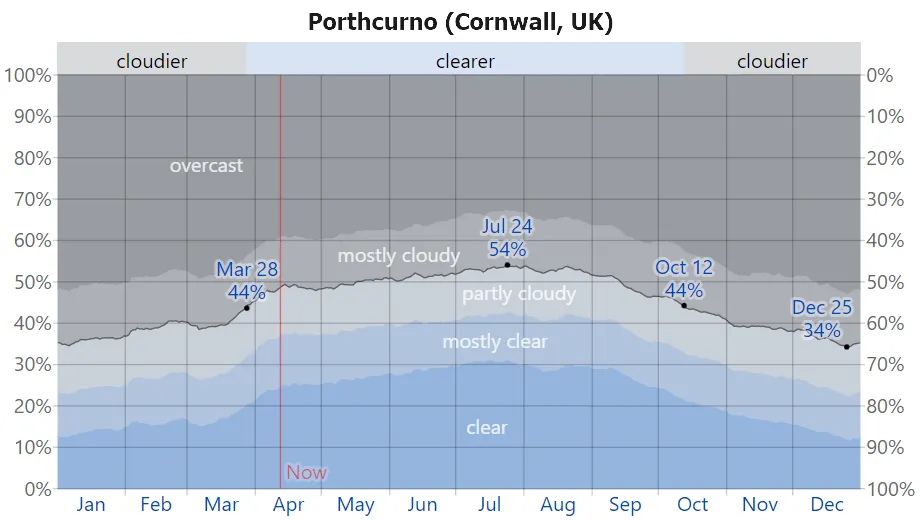
Pic. 27 The annual cloud coverage in Porthcurno (Cornwall, UK) with the day of April 8 marked as the red line (Weatherspark.com).
The casual observers will see the beginning of the partial eclipse with maximum obscuration of about 8% roughly at sunset. Because the northernmost location of the considered place, the twilight period is the longest. In turn, the greatest phase of the eclipse with obscuration over 85% will occur at the beginning of nautical dusk (solar depression of about 8°) (Pic. 28).

Pic. 28 The location of the Porthcurno coastal village against the extended path of totality within the astronomical twilight zone.
The greatest phase will occur at 20:50 local time (GMT+1). Unlike in previous places, there is no chance for watching the umbra in the atmosphere, although the slight fading out of the light southward should be noticeable by casual observers.
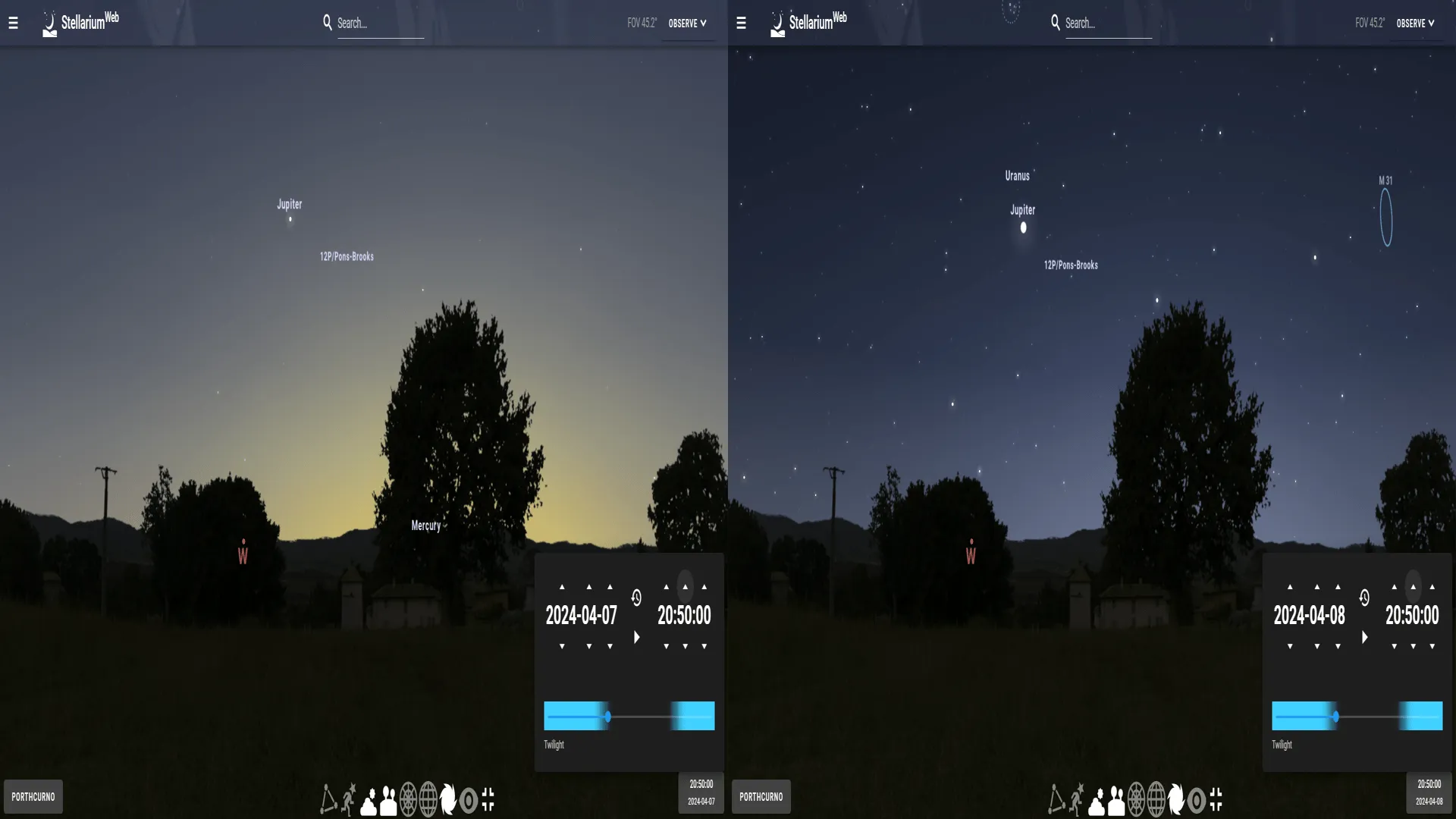
Pic. 29 The comparison of twilight between the 2024 eclipse twilight and a day before with the visibility prospect for 12P/Pons-Brooks comet in Porthcurno village (Stellarium-web.org).
The greatest eclipse should accelerate the twilight progress by over 2,5 degrees, making it like a late-nautical one with certainly good visibility of Jupiter and the brightest stars in the vicinity, including Hamal located on the right (Pic. 30-31).

Pic. 30-31 The general and detailed view at the 12P/Pons-Brooks position in the sky during the total solar eclipse below the horizon is estimated to be observed from Cornish shores when the eclipsed Sun is about 8º below the horizon (Stellarium-web.org – modified).
From the southern UK would be a chance to see the faint Mercury, but its position at the greatest phase will be very unfavorable, as the planet’s altitude it’s just 2º above the horizon and at its worst it is on the other side of the Sun, having the brightness of just with +4.4 Mag. The 12P/Pons-Brooks comet will be almost 15° above the horizon and hopefully, the greatest phase of the eclipse will help casual observers watch this beautiful celestial body before it plunges into a thicker atmosphere afterward.
Concluding the ground-based section, the 12P/Pons-Brooks comet will appear somewhere between Jupiter (-1.81 Mag) and Hamal (+2 Mag), which is the 50th brightest star in Earth’s sky including the Sun. The comet should make a straight line with Jupiter (-1.81 Mag) and Sheratan (+2.71 Mag), the second brightest star in the Aries constellation. Looking at all the maps above (Pic. 18 – 19, 24-25, 30-31) we can consider other bright stars in angular vicinity, which would act as anchor points when searching the 12P/Pons-Brooks comet in the sky.
MARINE TRAFFIC
The casual observers could be also passengers or crew of the ships sailing across the North Atlantic if they are aware of the eclipse event! (Pic. 32). It could be potentially a good way to watch the 12P/Pons-Brooks comet from open waters, far away from lands, where light pollution doesn’t affect the sky.
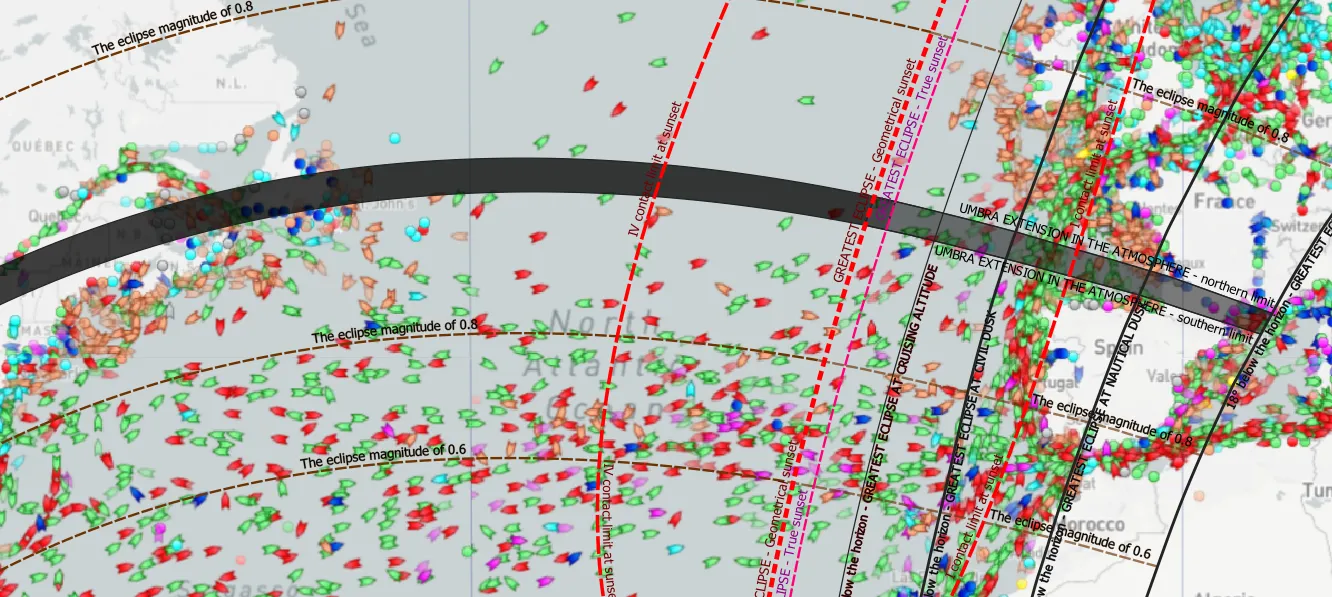
Pic. 32 Marine traffic estimated at the moment of the eclipse, retrieved for April 3, 2023, Monday, because April 10 was Easter Monday, which would result in some changes of schedules (Marinetraffic.com).
Unfortunately, Monday’s evening marine traffic isn’t as big within the path of totality, just slightly bigger with its extension on the Bay of Biscay. It can be explained as the proximity of the European continent. It’s worth taking a look at the intensive traffic between the southern UK and the Iberian Peninsula. It might be a good point to make aware people, who use this route on a daily or weekly basis (Mondays) and could be able to catch the eclipse event at twilight. Unfortunately, the major marine traffic across the Atlantic seems to be situated far south from the path, rather within the eclipse magnitude of 0.6 – 0.8, unless the ships head toward the British Isles. In their cases, crossing the extended eclipse path at the early stage of civil twilight is fairly possible. Indeed if anyone would record an observation such as this, it could be extremely beneficial in view of the fact, that the Sun is close to the horizon at that location, and passing umbra could be easily seen even on the clouds! The traffic in the eastern and central part of the Bay of Biscay, between France and Spain seems to be quite low. That’s a pity because this location seems to be the best for watching the 12P/Pons-Brooks comet.
CRUISING ALTITUDE
The weather-based problems are typical for ground-based observers, although we should take into consideration also the air traffic, which is quite intensive above Western Europe including the Bay of Biscay lying at the central extension of the umbra at twilight. On the open ocean, the traffic is less and restricted rather to long-haul flights. Because their flying azimuths are quite similar to the antisolar direction, passengers on one side of the plane could be able to see the umbra passing by nicely. Undeniably the best flights are these ones, which are oriented in North-South directions and cross the extended path of totality perpendicularly. The passengers sitting on one of the aircraft’s sides would experience a beautiful double-shadow phenomenon appearing in the pristine sky above the troposphere.
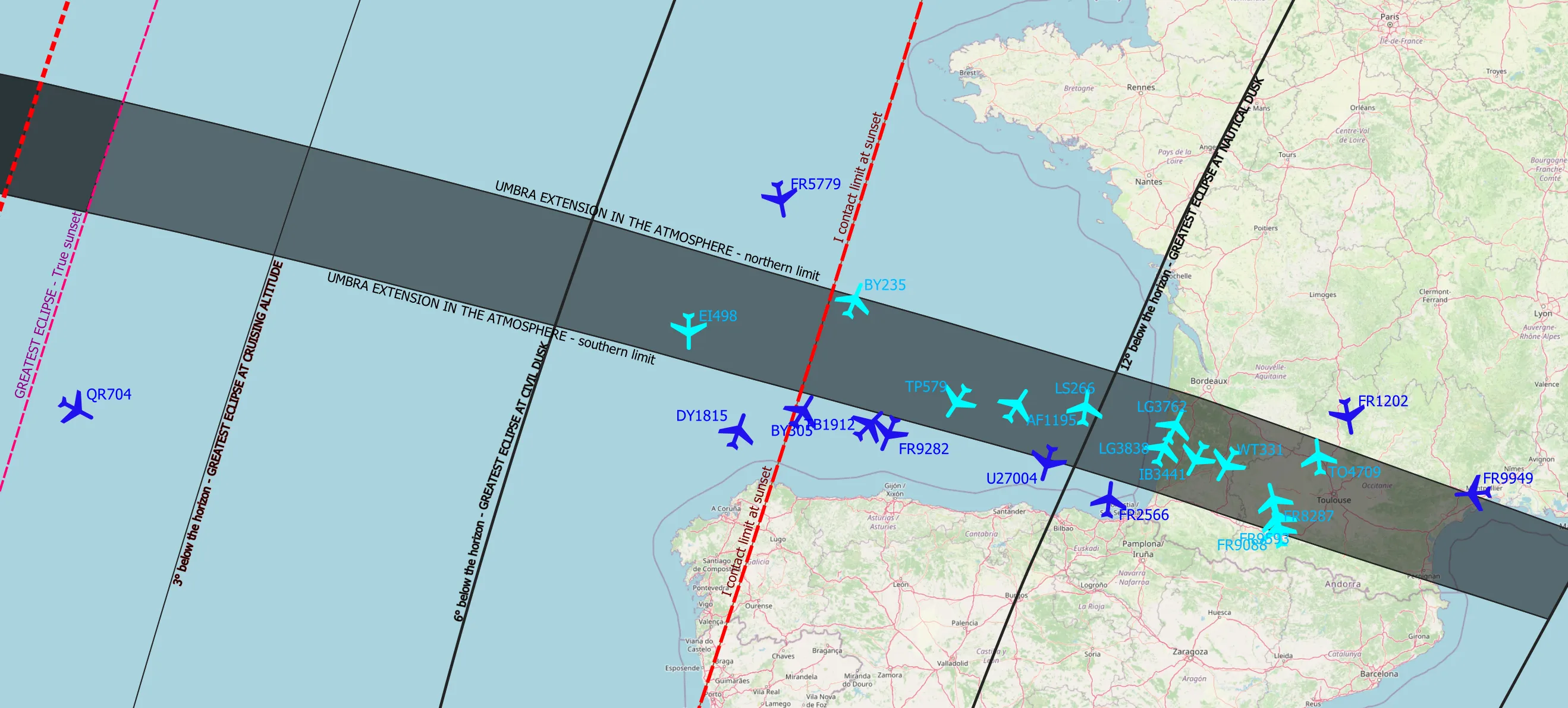
Pic. 33 Aircrafts at cruising altitude at the moment of the greatest eclipse phase in Western Europe. The view is on Monday, April 3 a year before the eclipse event on April 8, 2024. It should be Monday, April 10 as the reference day, although because it was Easter Monday some flights may have been changed.
Someone will be extremely lucky when will are able to capture this event. Obviously, the person must be aware of the eclipse event. Planning an observation such as this is quite hard because the scheduled departure time can vary from the real departure time sometimes quite significantly. If the plane departs too late it can miss the moment of the eclipse, assuming that anyone, who is concerned would book the plane with the departure adequate to the estimated flying time to the path extension.
The table below shows all the planes shown in the image above (Pic. 33) with their flight circumstances (Tab. 2).

Tab 2. The circumstances of every flight, which are visible in the image above (Pic. 33), especially departure time, flying azimuth, and altitude above ground at the moment of the greatest eclipse below the horizon. Important is also the red column on the right, which shows the departure delay. Sometimes it might be longer than 1 hour! The situation applies the Monday, April 3, 2023, exactly a year before the eclipse event on April 8, 2024. It should be Monday, April 10, but in 2023 it was Easter Monday, so some flights might have been changed. Click to enlarge.
One of the best flights for catching the eclipse event at dusk could be from London (STN) to Faro (FAO), departing at 19:10 BST (GMT+1) from London Stansted. Another one from Dublin (DUB) to Faro (FAO) with a scheduled departure at 19:15 BST (GMT+1) from Dublin International Airport. The third one on the list could be from Frankfurt am Main (FRA) to Lisbon (LIS) with scheduled departure at 19:40 CEST (GMT+2) and so forth.
As far as the flight departs on time, chasing the eclipse event this way makes sense, as the vast majority of the weather problems are left beneath. Important is booking a flight with a proper window seat located in the same direction, where the event is going to be observed. It’s an analog approach to the situation when we are going to see some distant mountain range from the plane, about which the discussion was in this article. Obviously, when twilight is deeper, the observation conditions will be accordingly worse for a mundane reason – the cabin crew turns the light on, which results in the unnecessary reflections on window plexiglass, deteriorating the view outside. It can be really problematic for the observation of twilight affected by a total solar eclipse. Interesting, but extremely hard to capture would be also the sky view in the antisolar direction. However, considering the aforementioned obstacle it seems to be unrealistic unless the plane flies within the early civil twilight zone.
7. SOLAR ECLIPSE BELOW THE HORIZON – NOMOGRAM AND TWILIGHT STANDSTILL EXPLANATION
Having some scant background with observations of total solar eclipse below the horizon, which were so far described here and about a year and a half later I’ve prepared the nomograph showing the eclipse’s impact on the twilight. It’s just the first approach for a matter such as this, which will be developed further in the future, especially since the observation data refers just to webcam observations. They, because changing their ISO settings might provide results, which aren’t valid enough. It is definitely a matter for on-site observations especially the light level measurements leading to the reveal of how the twilight standstill phenomenon looks like.
Analyzing Hoffman’s pattern below (Pic. 34), the twilight standstill phenomenon would apply just for a circa 15-minute period, in which the progression of dusk or dawn is “frozen” because of the solar eclipse disturbance.

Pic. 34 The chart shows the impact of the deep partial solar eclipse on twilight on the morning of July 22, 1990, with a comparison to non-eclipsed dawn 2 days later (Hoffman, Geyer, Volland, 1994). The rectangles indicate the moments of a twilight standstill: the red one – about 15 minutes, the blue one – about 5 minutes just before the eclipse reached the greatest phase.
It refers to the July 22, 1990, total solar eclipse, which was observed from western Germany at its deep partial phase. Every eclipse is different, but the primary regularity is, that for the deepest eclipse phases (or geometrically extended total phases) we can say about 2 moments of twilight standstill, where the one occurs somewhere after the “halfway” between I and II contacts, and the second one just before II contacts or the greatest phase. For less deep partial phases only one moment such as this can be observed. When the partial eclipse has a “too shallow” phase, then the phenomenon cannot be observed, because light level changes caused by twilight progression are faster than the same changes caused by the progress of the eclipse.
Looking at the solar eclipse below the horizon nomograph below, we can read about the estimated twilight progression characteristical for the specific obscuration of the solar disk (Pic. 35).
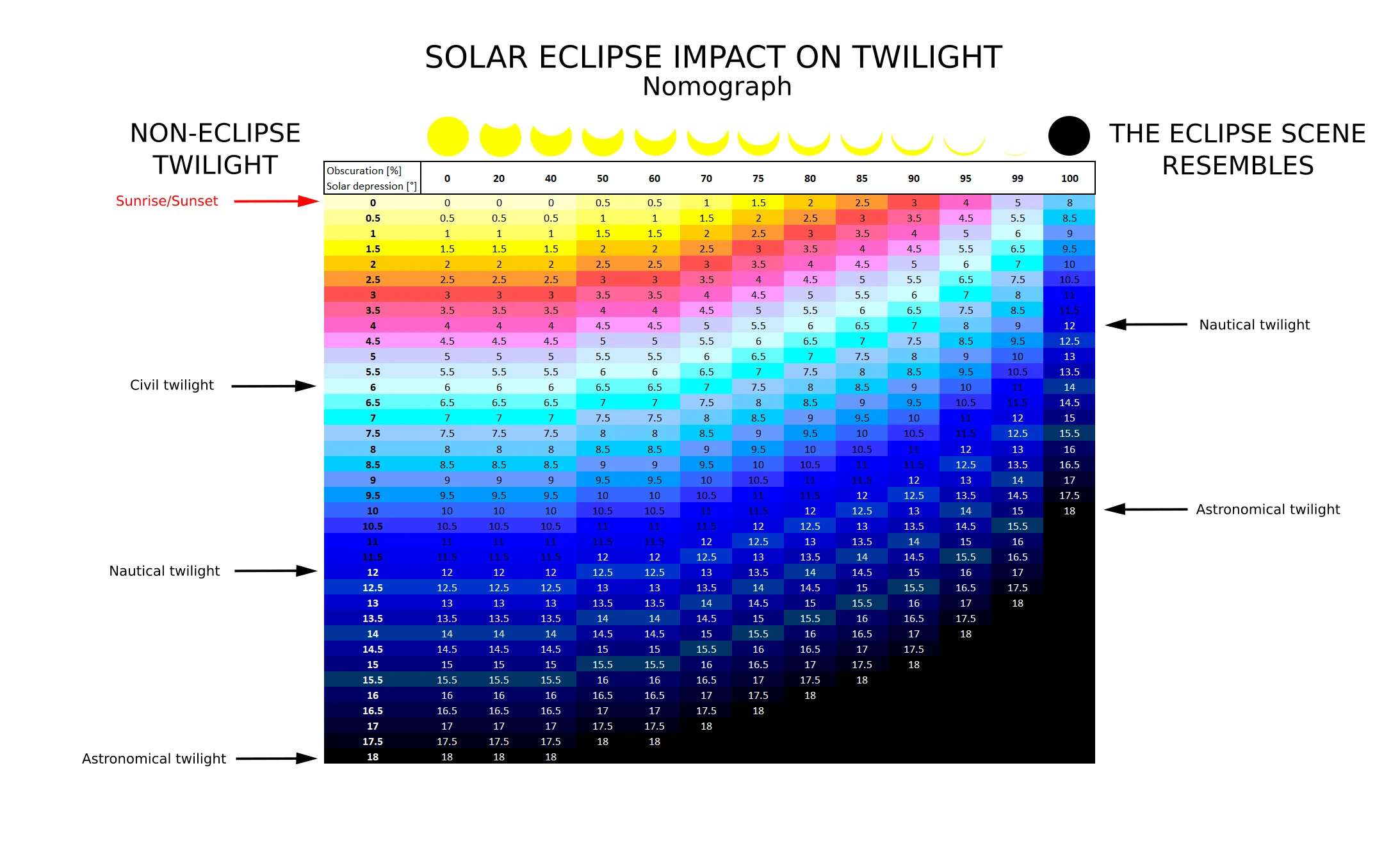
Pic. 35 The nomograph of solar eclipse below the horizon displaying the general impact of the eclipsed Sun on the twilight period with respect to the twilight stage and eclipse obscuration at the given moment. Click to enlarge.
The monograph above explains what happens in twilight affected by solar eclipse depending on its phase (solar disk obscuration). As it has been observed a few years ago, the sunset eclipse corresponds pretty much to early nautical twilight with a solar depression of 8°. Leading the twilight progression linearly, we would receive the nautical twilight condition already when the total eclipse occurs just 4° below the horizon, though the scene resembling the astronomical twilight would be typical already when the eclipsed Sun is just 10º below the horizon. In this case, the observers of the 12P/Pons-Brooks comet would gain precious 8° for significant improvement in the observation conditions. Unfortunately, these circumstances aren’t achievable anywhere from land, so it would have to happen on the western part of the Bay of Biscay.
For another location – Northwestern Spain, the eclipse conditions with the obscuration of 96% would resemble almost mid-astronomical dusk. Finally, for the Cornwall-based observers, the scene would be typical for the moment of solar depression of about 10° (late nautical dusk).
This nomograph represents some simplified approach based rather on the observed level of light scattering. We must be aware, that regardless of the scene illumination, the scattered light will still reach a casual observer’s eye from outside of the extended umbral path. This is exactly the thing, which requires computations and on-site observations with exact measurements. As far as I am concerned nobody except the M. Hoffman team undertook this beautiful and intriguing astronomical occurrence.
8. SUMMARY
The article considered the best opportunities for watching the 12P/Pons-Brooks comet during the April 8, 2024, total solar eclipse if it exists at all. As per other discussions on the web, no one can confirm, that the comet will appear in the sky along with the totally eclipsed Sun. This is because, the watching prospect of this Halley-type celestial body is disadvantageous, the same as recently, 71 years earlier. It’s undeniable, that the object will reach enough apparent magnitude to make it visible to the naked eye. On the other hand, the observers might encounter some difficulties, as it’s a near-sun object and will disappear beyond the horizon not long after sunset. The date of 8 April doesn’t mark the perihelion of the comet, which is calculated to occur on April 25. The problem is, that at the perihelion day, the comet will have less profitable declination for American and European observers as it moves south in the sky. Moreover, the full Moon occurs that day. Since the visual appearance of the 12P/Pons-Brooks comet along with the totally eclipsed Sun is unlikely, the other circumstances have been considered. They admittedly refer still to the 2024 total solar eclipse day, but cover the path extension within the twilight zone reaching western Europe. It has been concluded, that unlike North American observers, who probably will have a better comet view in the evening, exactly Europeans might have perfect conditions for watching this comet.
Analyzing the twilight disturbance caused by the solar eclipse, we can expect a significant acceleration of twilight progress, which will allow us to see the 12P/Pons-Brooks comet quite high above the horizon under night-looking conditions. Admittedly, Western Europe probably will have the world’s best conditions for watching the 12/P Pons-Brooks comet in its near-perihelion position driven by the impact of the total solar eclipse.
Because of the faint brightness of the object, calculated at just +4.71 Mag its visibility could be possible beyond the solar depression of at least 8°. These conditions are rather unachievable during a total solar eclipse unless it occurs near sunset. However, the solar eclipse extension within the twilight zone probably will give a fantastic “window” of time counting roughly 2m13s, in which all the observers from Western Europe should concentrate their efforts and capture this gorgeous celestial object. Unfortunately, the best-concluded place for the 12P/Pons-Brooks comet will probably fall on the western part of the Bay of Biscay, where the total solar eclipse will occur at an altitude of 10° below the horizon and the comet will be visible about 13° above the horizon. A good choice could be the Nouvelle-Aquitannie shores lying roughly at the extension of the totality path, where the greatest eclipse will occur at a solar altitude of 13° below the horizon with comet presence about 10° above the horizon. Unfortunately, the weather prospect is the thing, which will worry everyone, who would like to see it.
The article also concludes the impact of the solar eclipse on twilight, which results in the twilight standstill phenomenon. Unfortunately, the observation data of events such as this are really scant and definitely require attention and contribution in the future. I mostly mean casual observers – local people living in the areas, where the phenomenon is expected to occur. The below-the-horizon section of the eclipse is an inherent part of most eclipses and is definitely worth attention. It’s good to prepare European people for the next one, which is expected in 2026. I hope, that this small piece of Earth’s atmosphere phenomena will be finally studied in a decent manner.
Mariusz Krukar
References:
- Gulyaev R.A., 1992, On a possible use of total solar eclipse below the horizon for observations of the inner zodiacal light (as applied to the eclipse of June 30 1992), Kluwer Academic Publishers
- Herget P., Carr H.J., 1972, The Motion of Periodic Comet Pons-Brooks 1812-1954, (in:) The Motion, Evolution of Orbits, and Origin of Comets; Proceedings from IAU Symposium no. 45, held in Leningrad, U.S.S.R., August 4-11, 1970. Edited by Gleb Aleksandrovich Chebotarev, E. I. Kazimirchak-Polonskaia, and B. G. Marsden. International Astronomical Union. Symposium no. 45, Dordrecht, Reidel, p.195
- Hoffmann M., Geyer E.M., Volland H., 1994, Influence of a solar eclipse on twilight, (in:) Applied Optics, vol. 33, Issue 21, p.4614-4619
- Kastner S.O, 1976, Calculation of the twilight visibility function of near-sun objects, (in:) Journal of the Royal Astronomical Society of Canada, vol. 70, Aug. 1976, p. 153-168
- Meeus J., 2007, Mathematical Astronomy Morsels IV, Willimann-Bell
- Meyer M., Kobayashi T., Nakano S., Green D.W.E., 2020, Comet 12P/Pons-Brooks: Identification with Comets C/1385 U1 and C/1457 A1, (in:) International Comet Quarterly
- Nickiforov N.G., 2011, Model of the stellar visibility during twilight, (in:) Bulgarian Astronomical Journal
- Quanzhi Y., Tony F.L., Knight M.M., et al., 2020, Recovery of Returning Halley-type Comet 12P/Pons-Brooks with the Lowell Discovery Telescope, (in:) Research Notes of the AAS, Volume 4, Issue 7
- Tebutt J., 1884, Observations of the Comet of 1812 (Pons-Brooks) at its return to Perihelion in 1884, (in:) Monthly Notices of the Royal Astronomical Society, Volume 44, Issue 9, July 1884, p 445–450
- Tousey R., Koomen M.J., 1953, The visibility of stars and planets during twilight, (in:) Journal of the Optical Society of America, Vol. 43, Issue 3, p. 177-183
- Tomko D., 2015, Modeling of a theoretical stream of comet 12P/Pons-Brooks, (in:) Planetary and Space Science, Volume 118, p.35-37
Links:
- http://cometography.com/pcomets/012p.html
- Ssd.jpl.nasa.gov: Small body database lookup – 12P/Pons-Brooks
- Theskylive.com: The current position of the 12P/Pons-Brooks comet
- https://www.rocketstem.org/2020/04/04/ice-and-stone-comet-of-week-15/
- https://www.spacereference.org/comet/12p-pons-brooks
- Heavens-above.com: 12P/Pons-Brooks comet real-time positon
- Astro.vanbuitenen.nl: 12P/Pons-Brooks – estimated circumstances in 2024
- Aerith.net: 12P/Pons-Brooks (2024)
- https://www.newsweek.com/next-naked-eye-comet-earth-long-wait-1775120
- Twitter.com: 12P/Pons-Brooks recovered on June 27, 2020
- http://cometes.obspm.fr/en/chasseurs-cometes-0.html
- https://britastro.org/pdf/CometSection/tail40.pdf
- https://www.ancient-origins.net/opinion-guest-authors/comet-changed-civilization-and-may-do-again-006770
- Comets prospects for 2024
- Aerith.net: Visual comets in the future
- In-the-sky.org: 12P/Pons-Brooks comet
- https://www.glyphweb.com/esky/comets/pons-brooks.html
- https://www.sott.net/article/439004-Recovered-Halley-type-comet-12P-Pons-Brooks-may-peak-during-Americas-next-total-solar-eclipse-in-2024
- https://highsierraimaging.com/2024-solar-eclipse
- Facebook.com/GreatAmericanEclipse: The 12P/Pons-Brooks comet position during 2024 totality
Forums:
Wiki:

